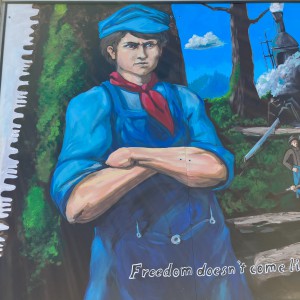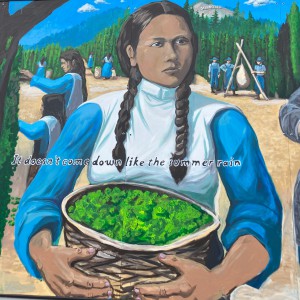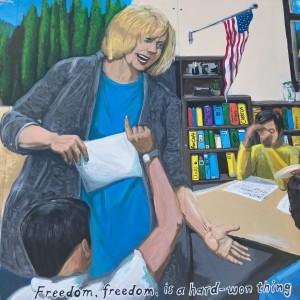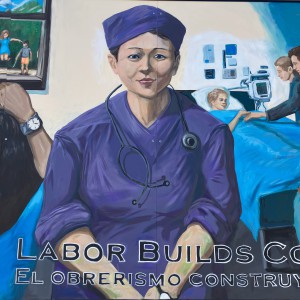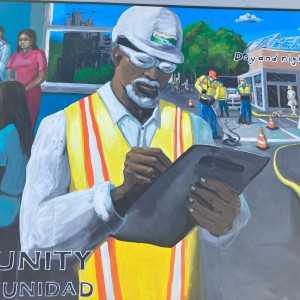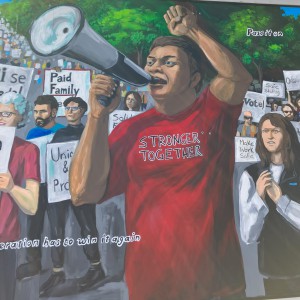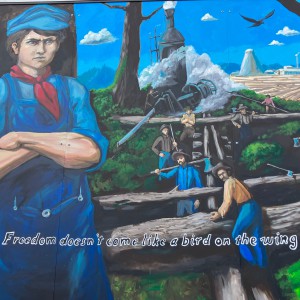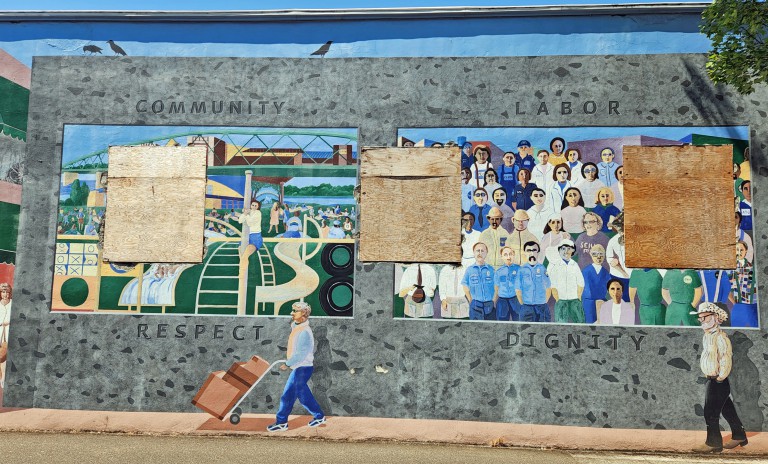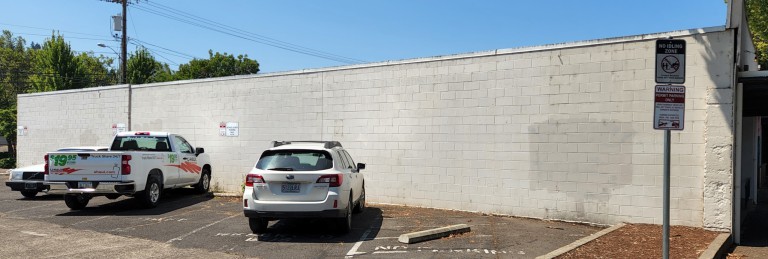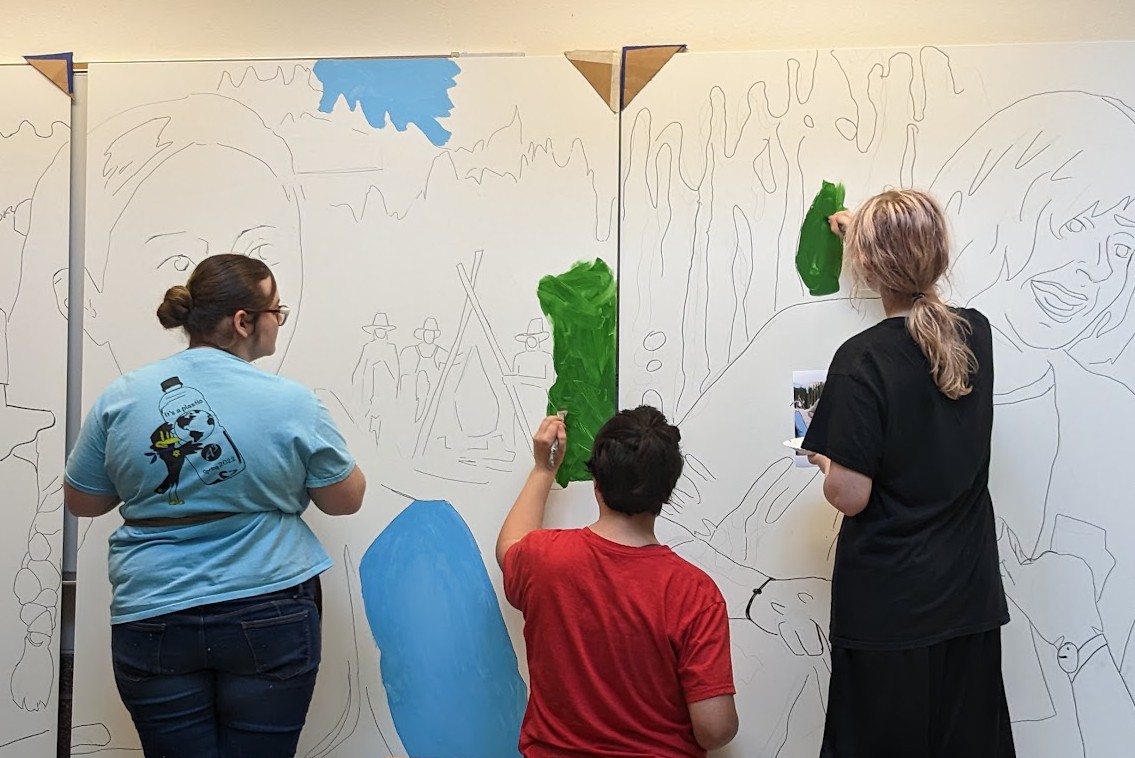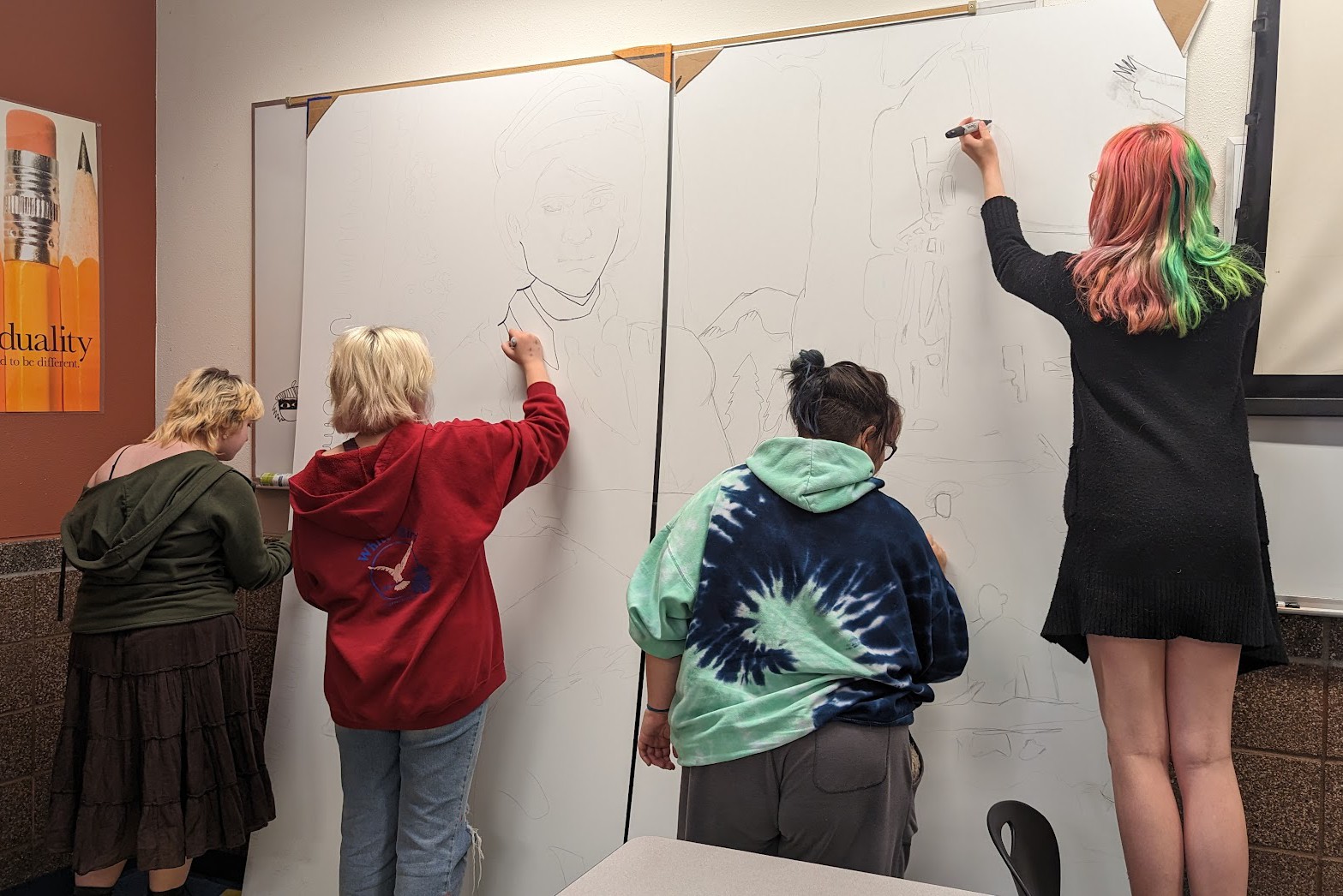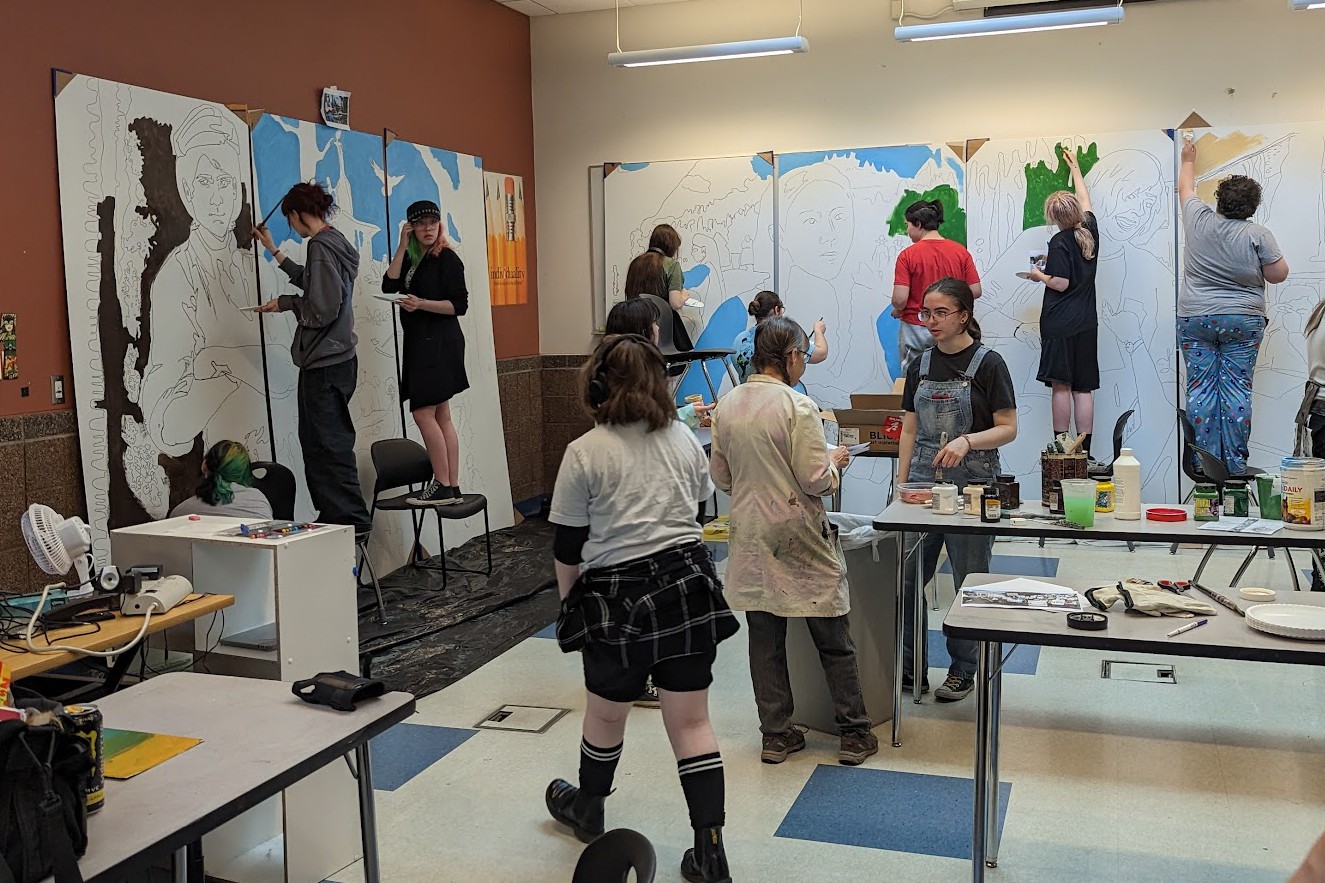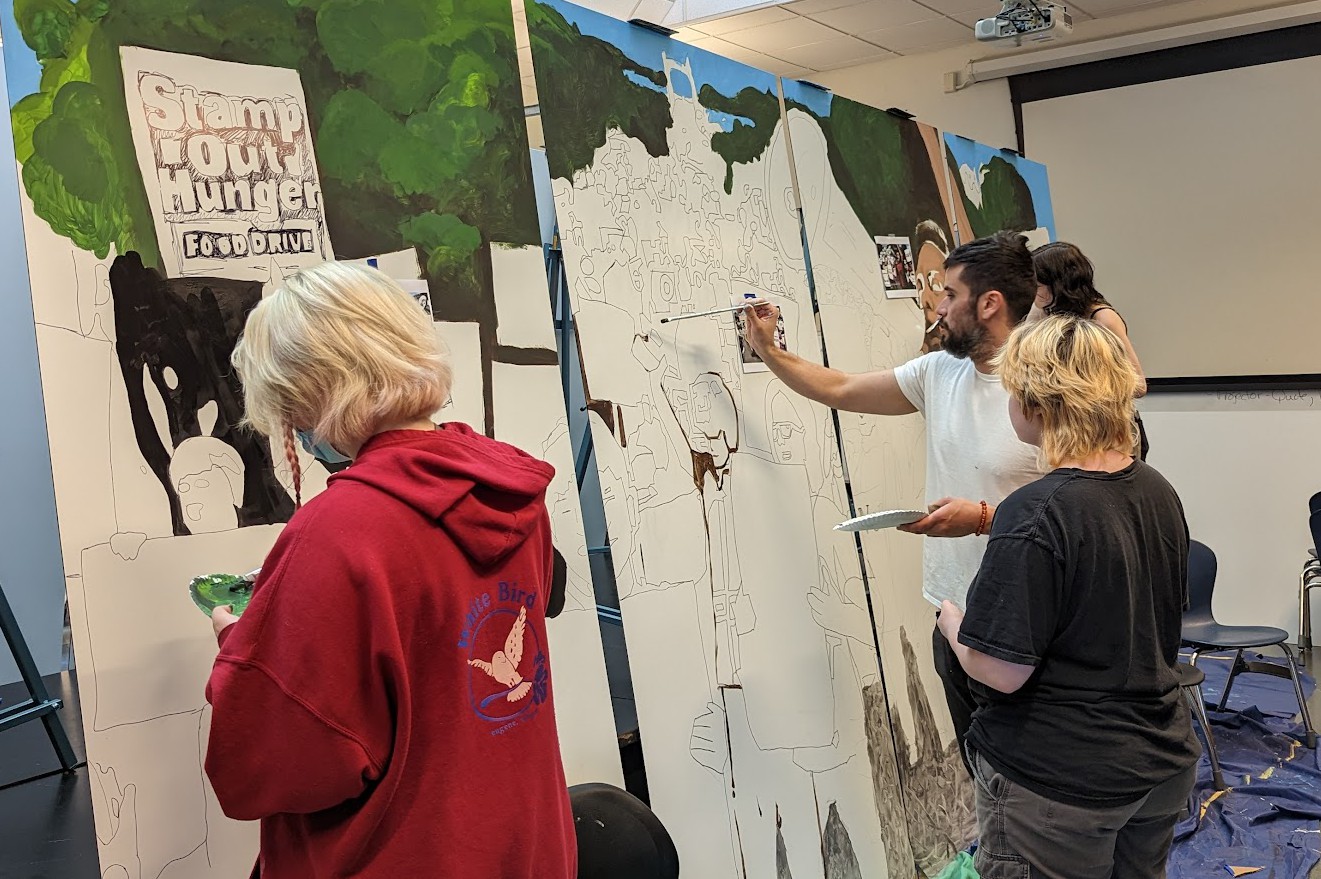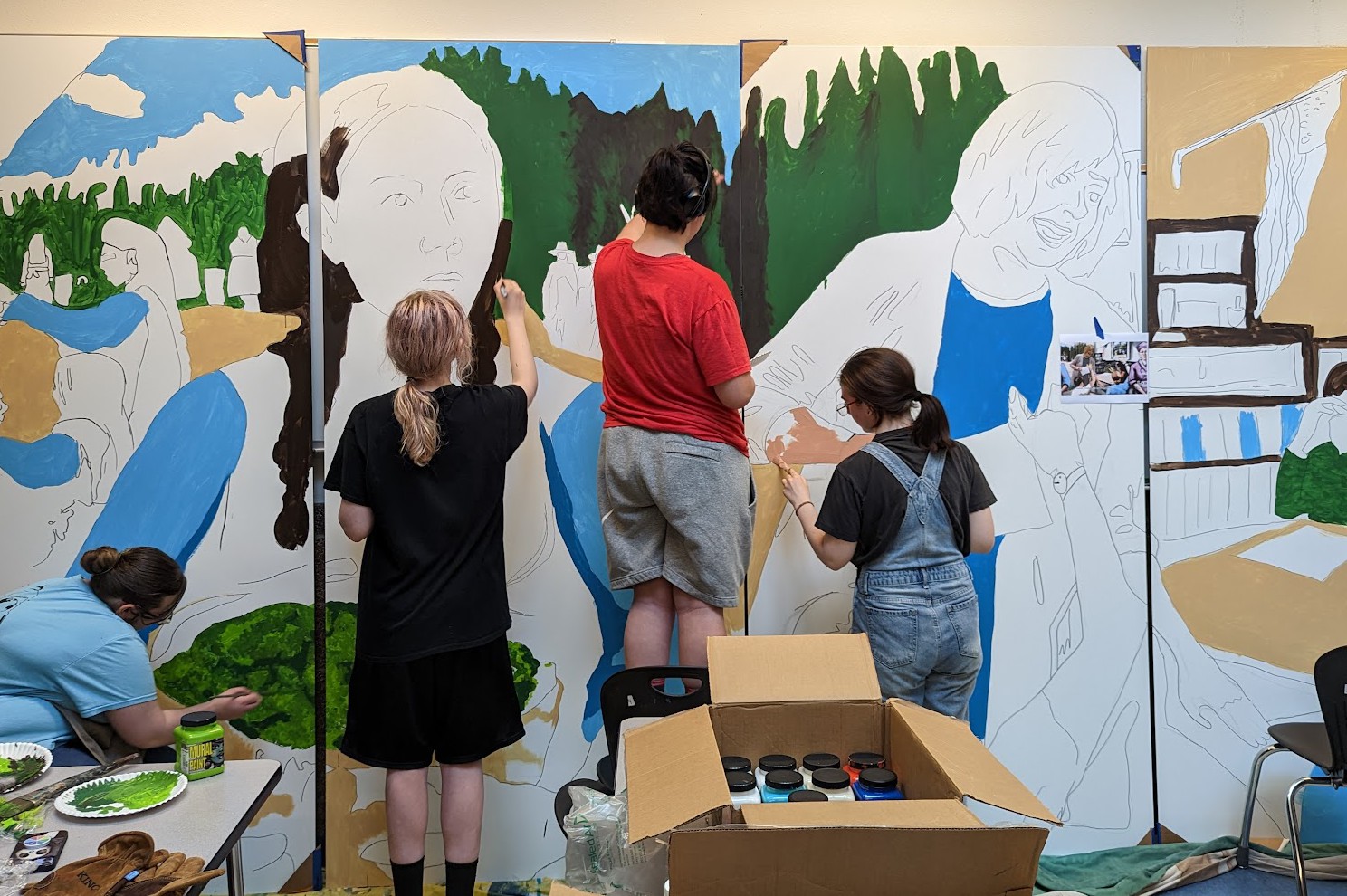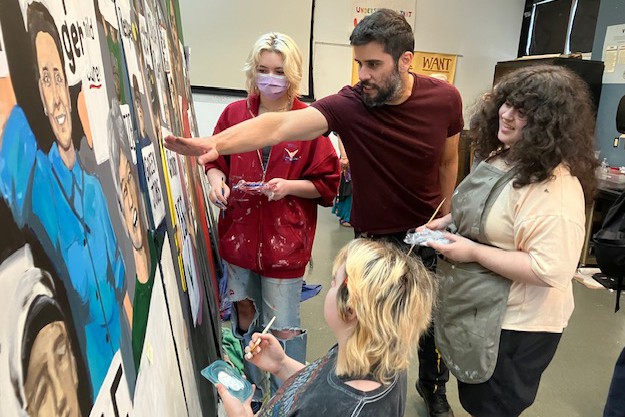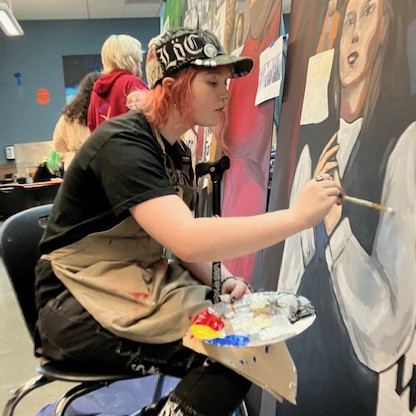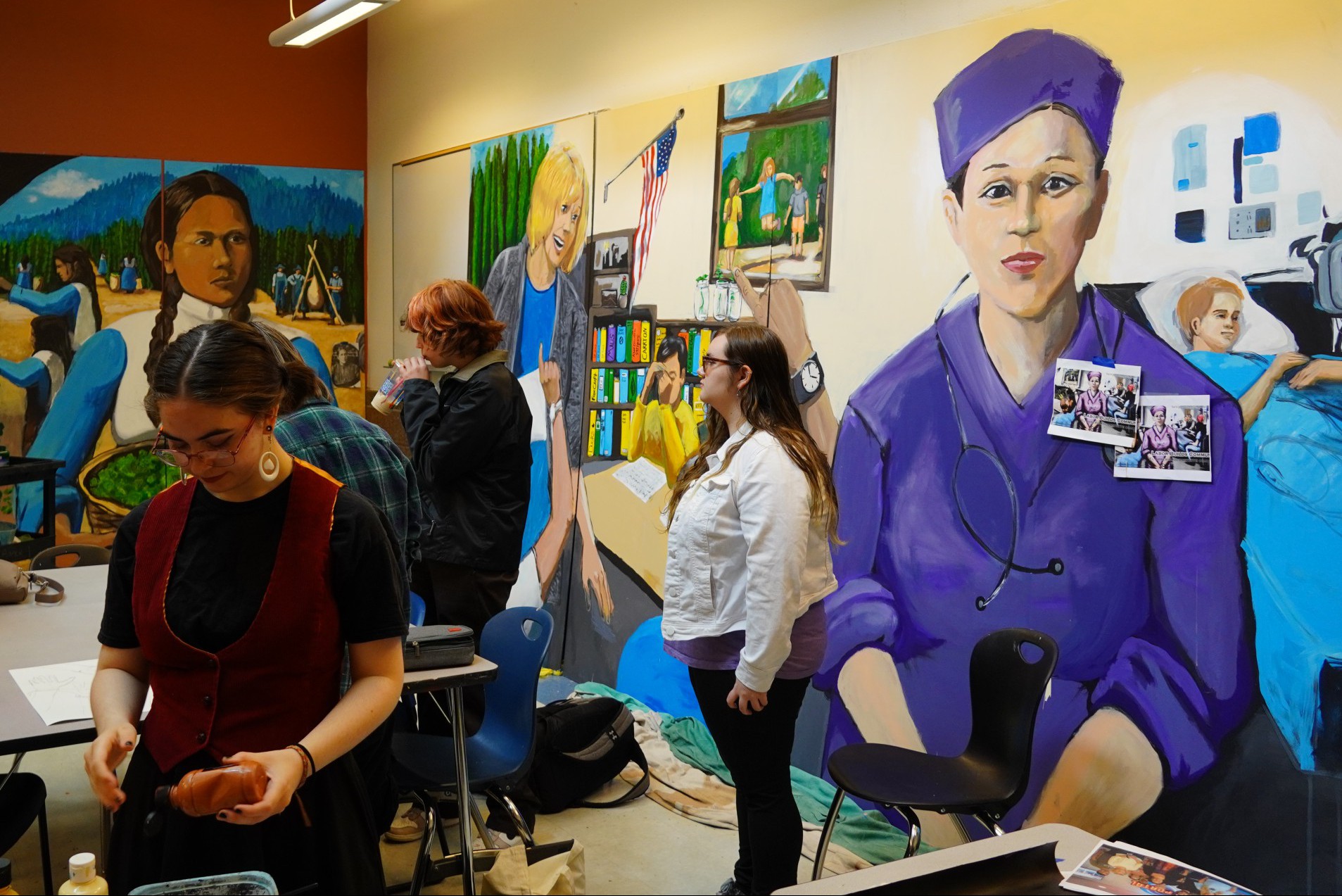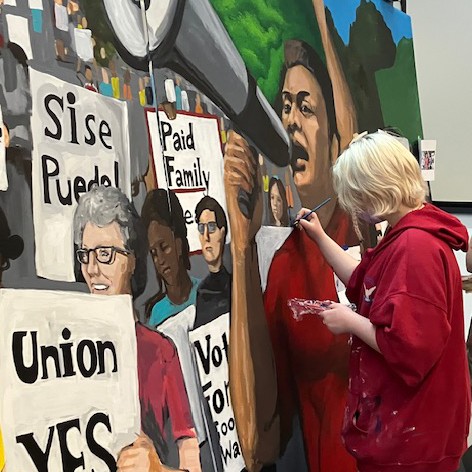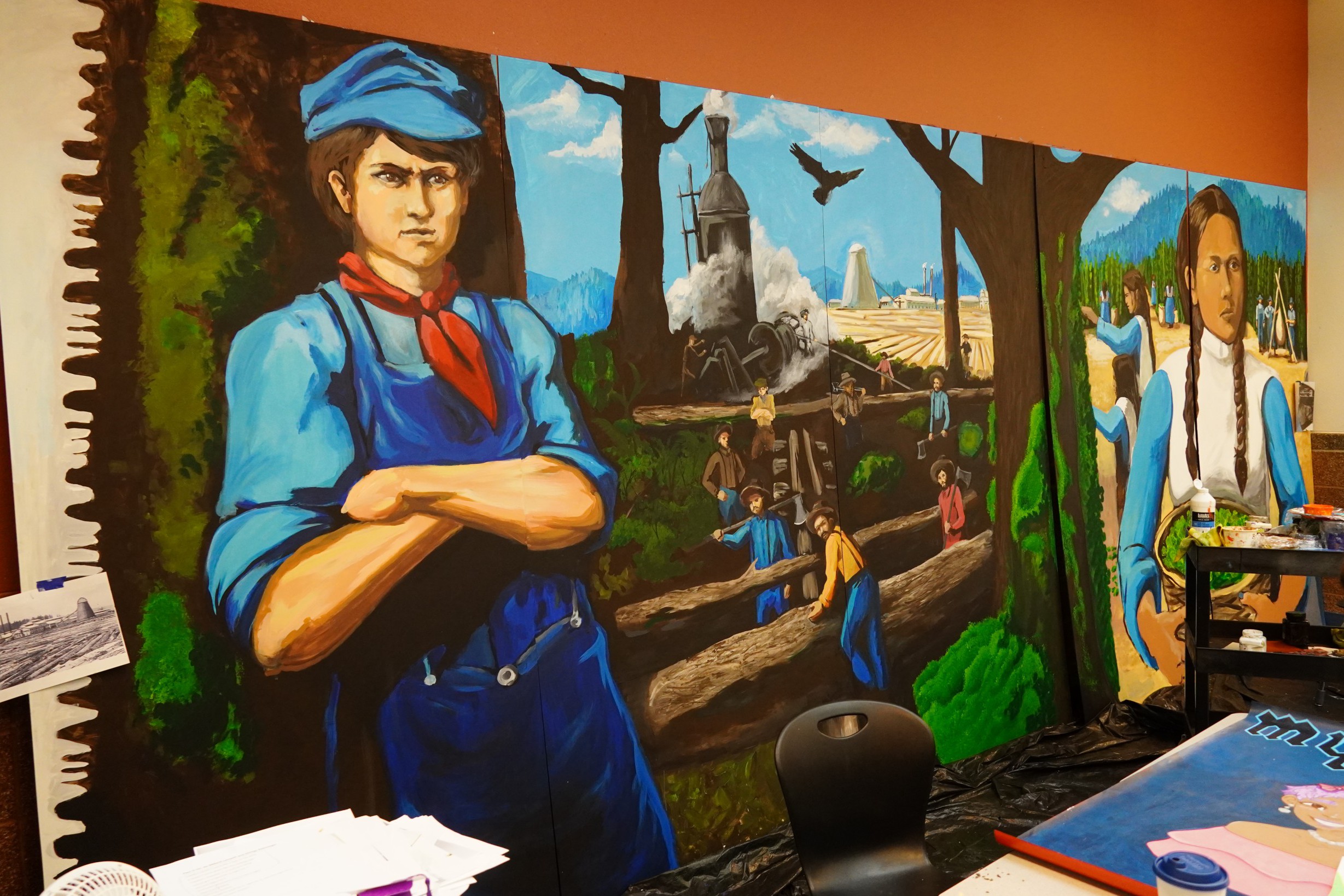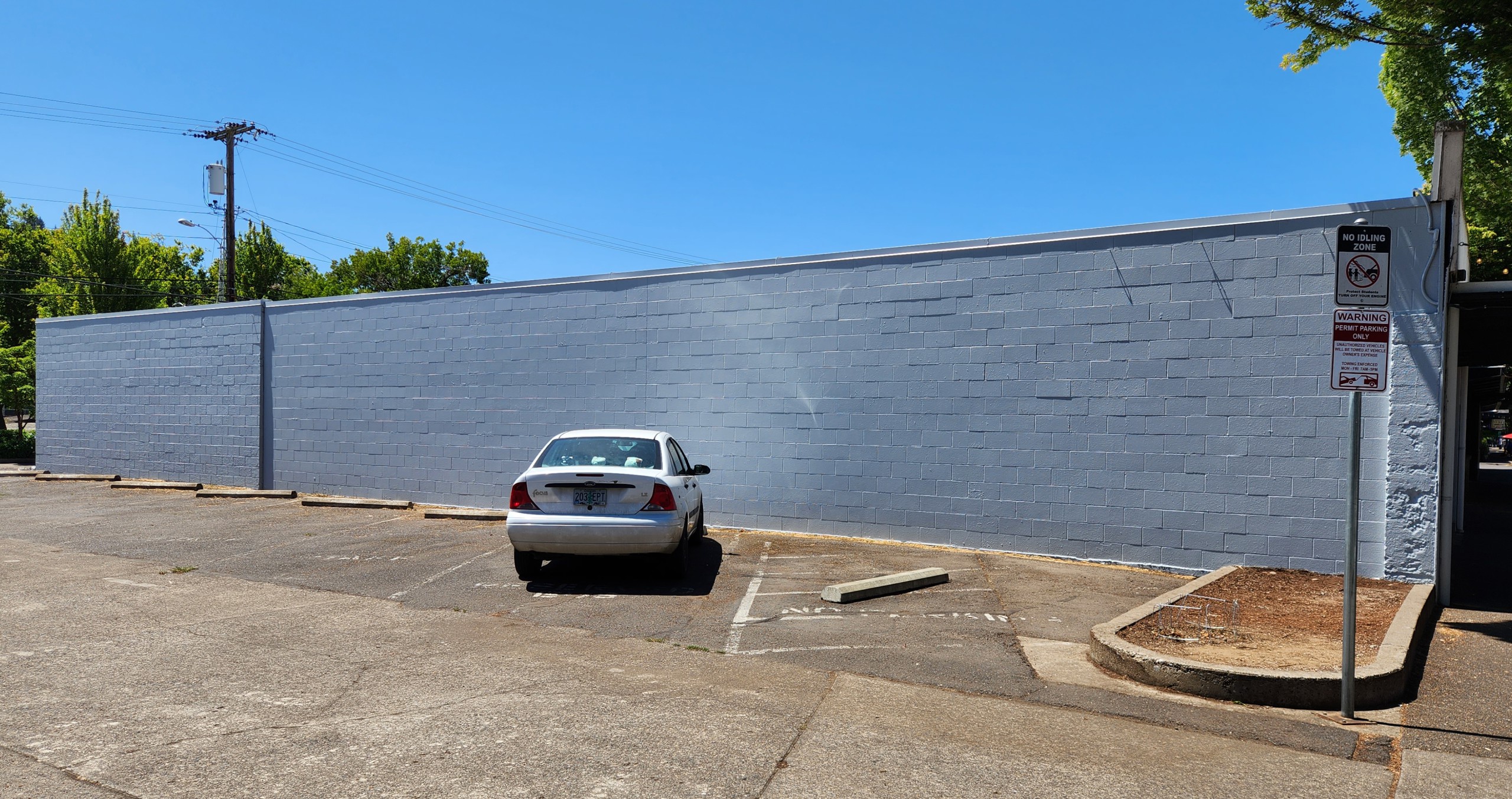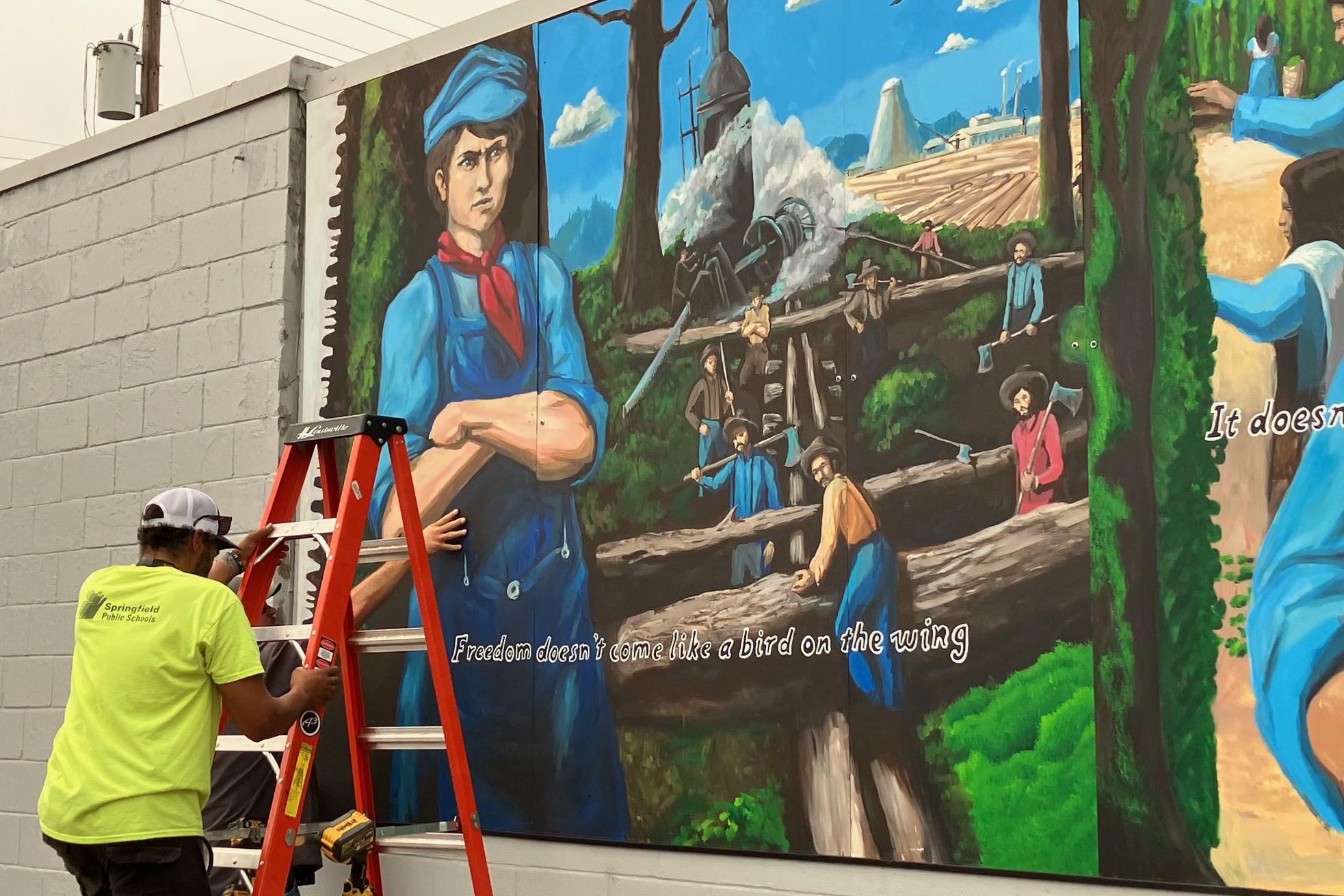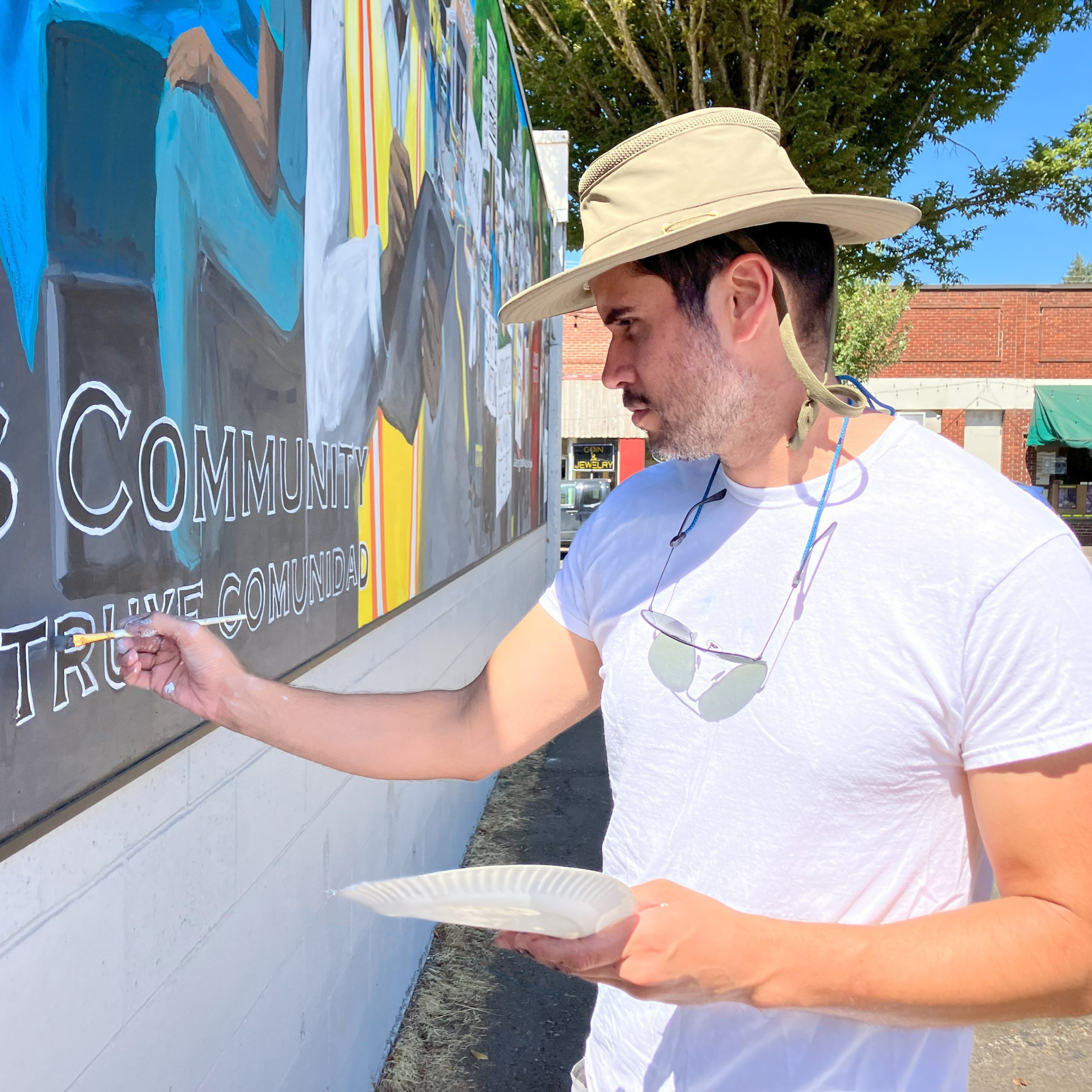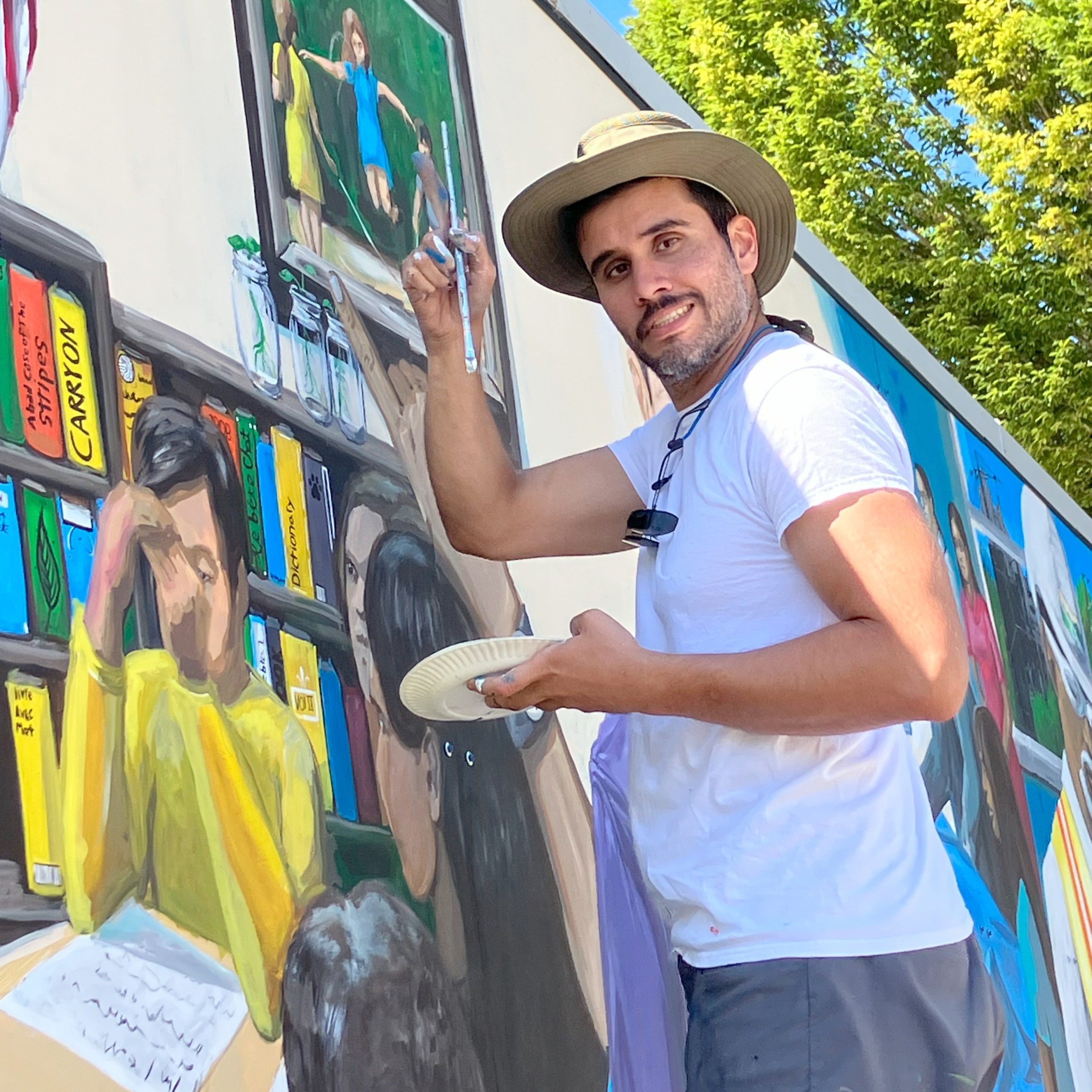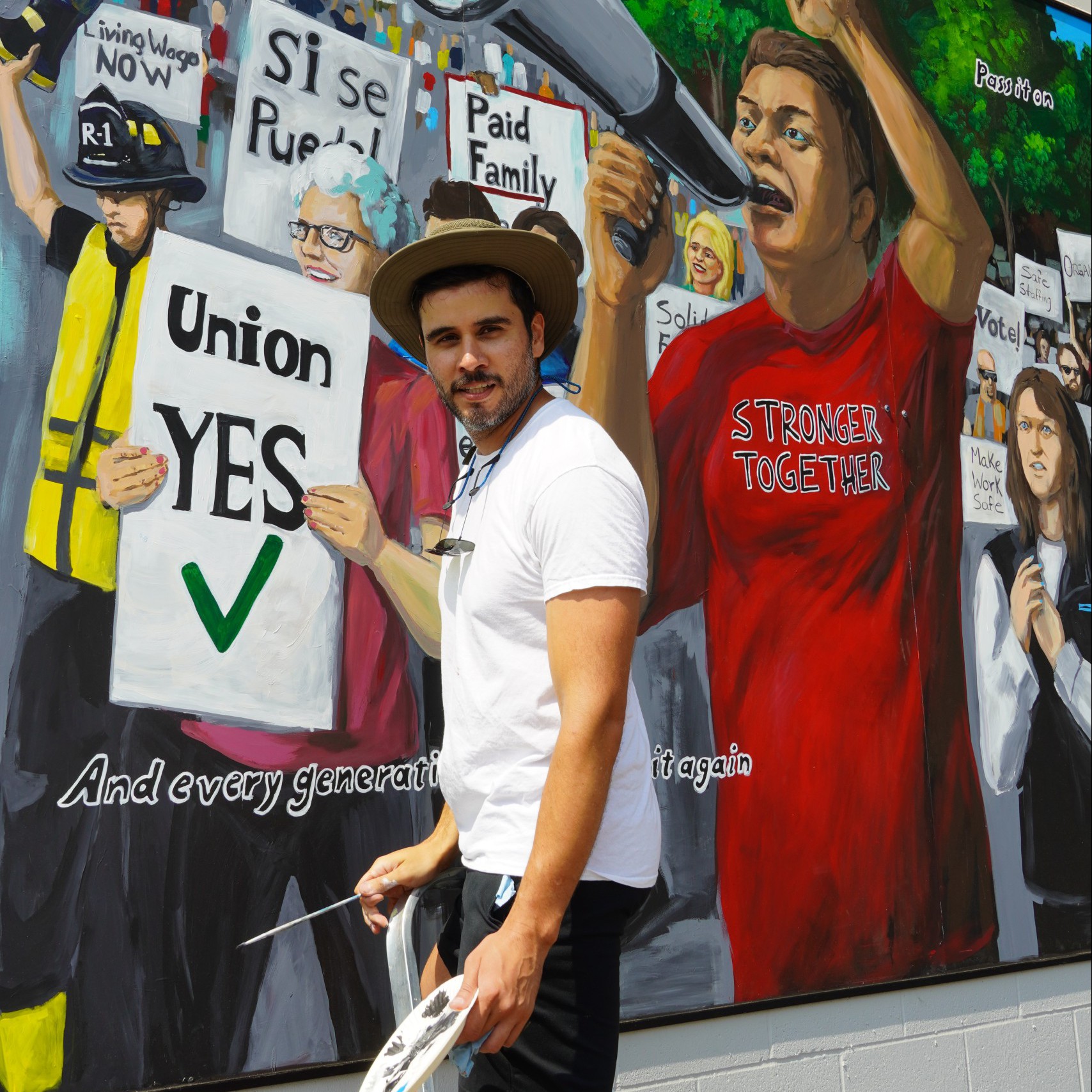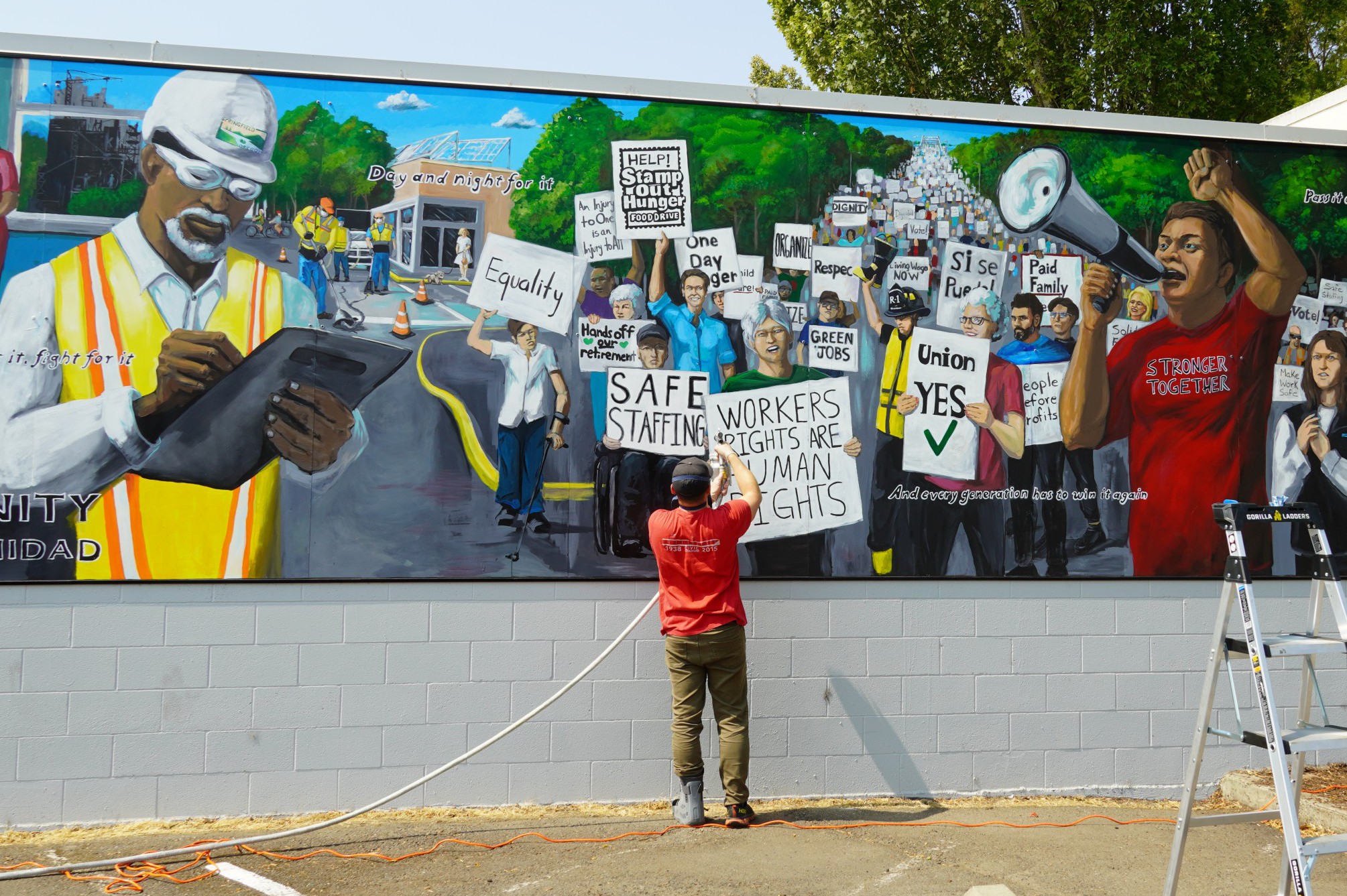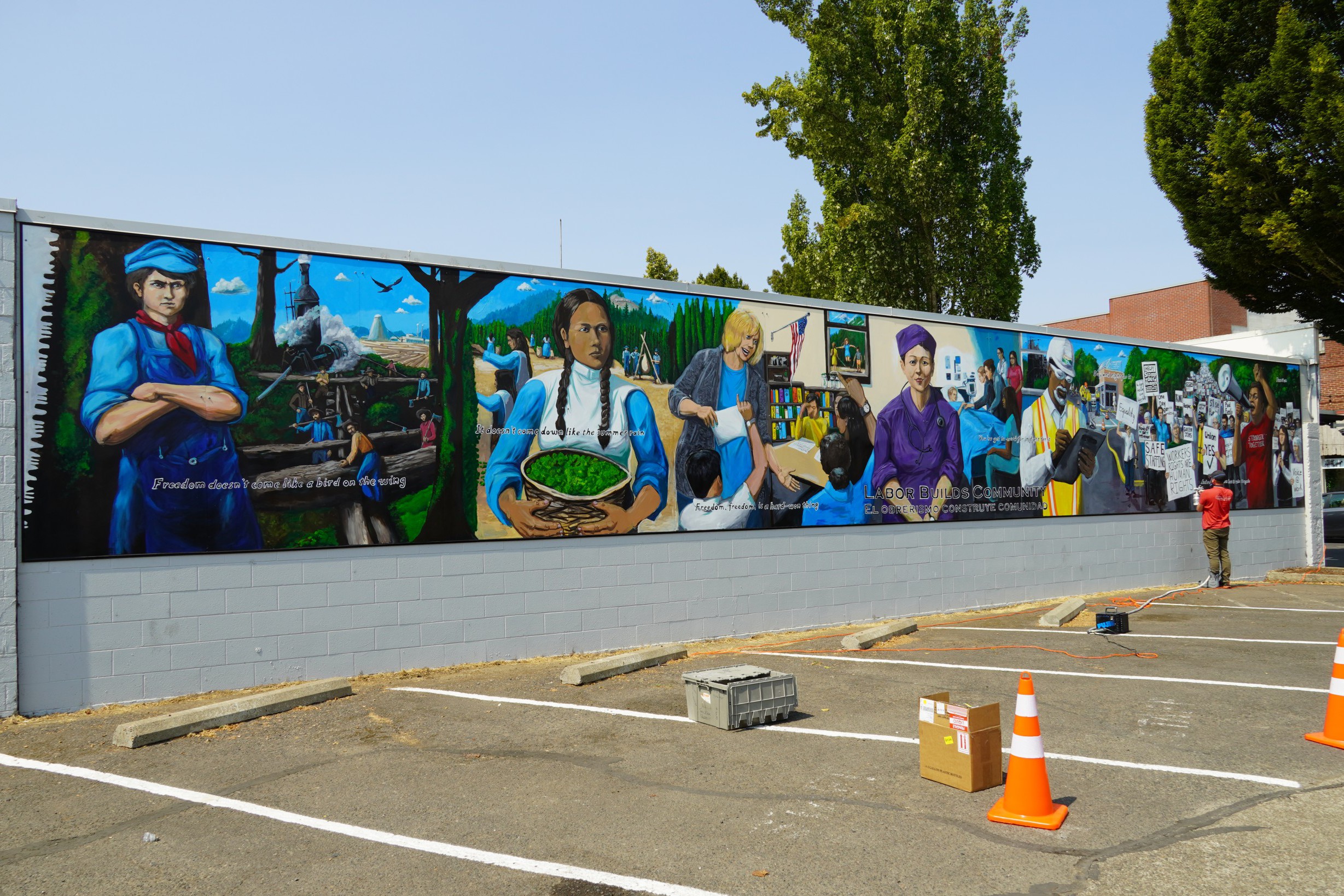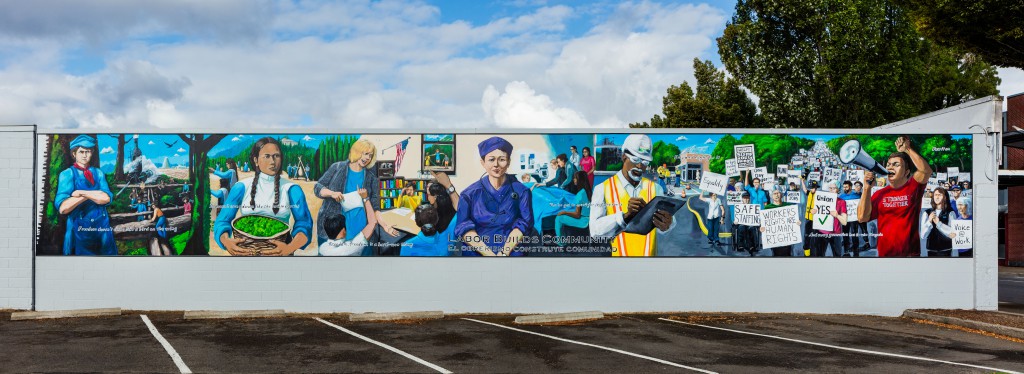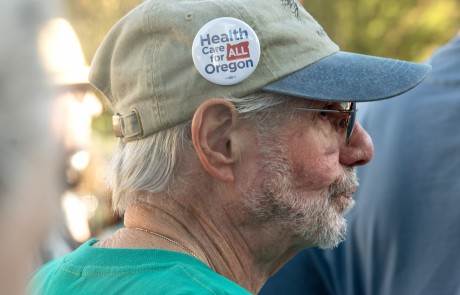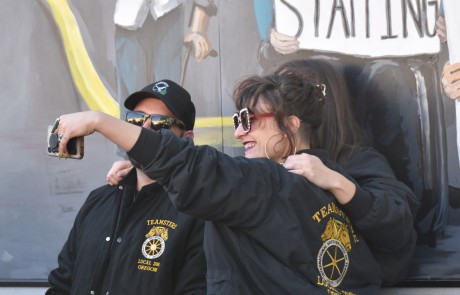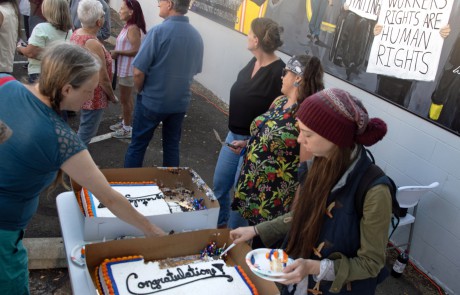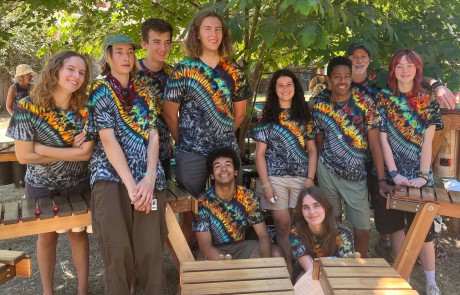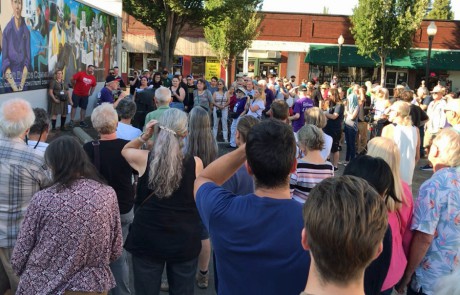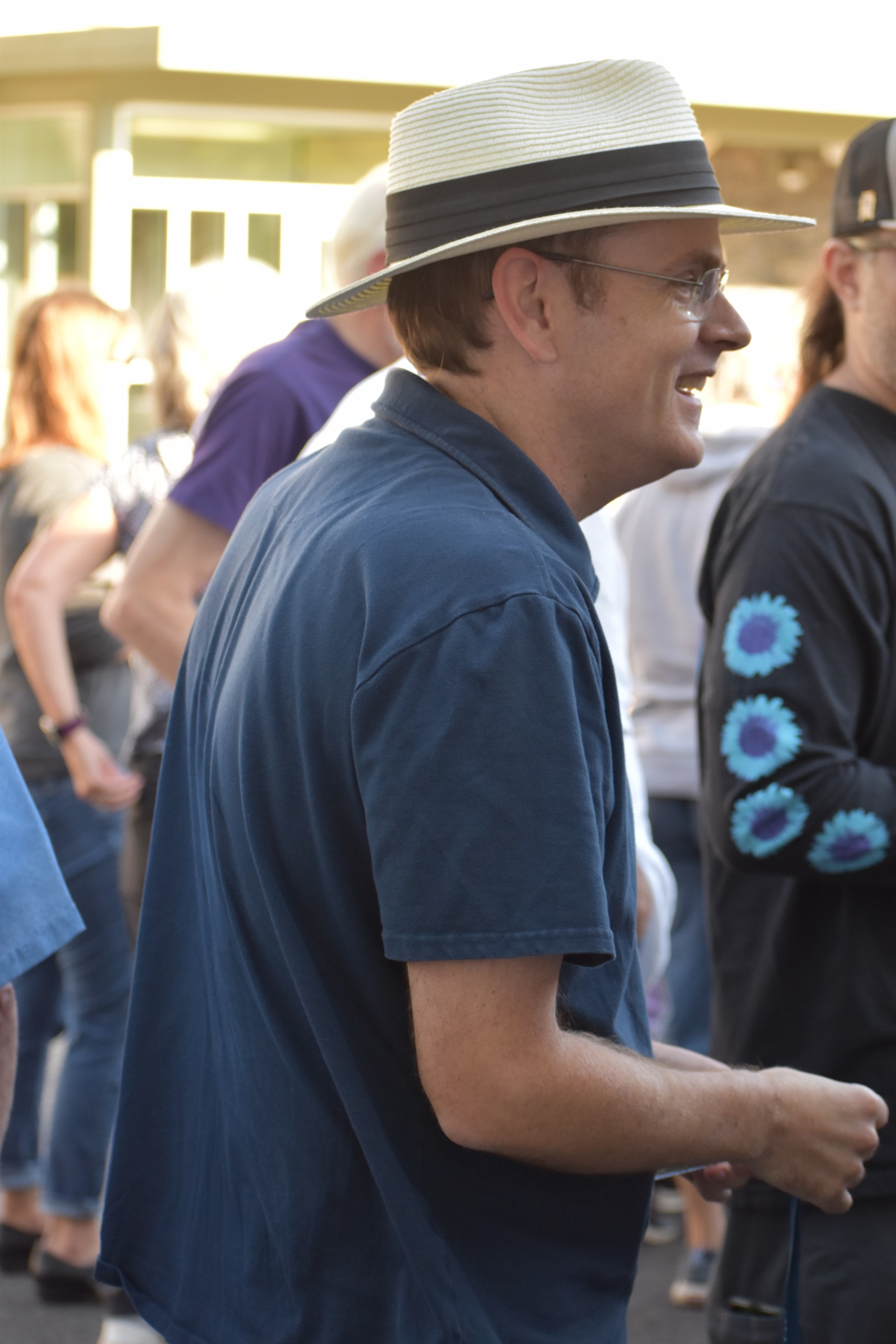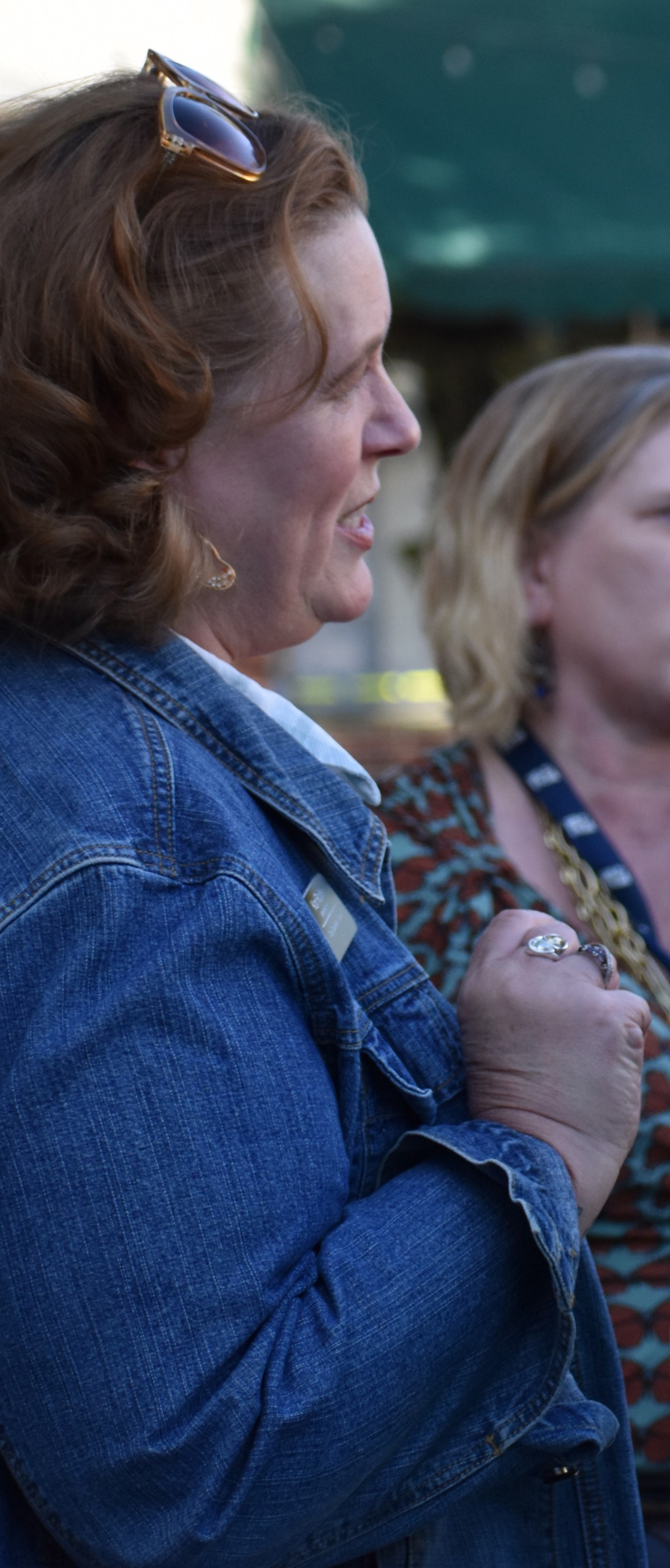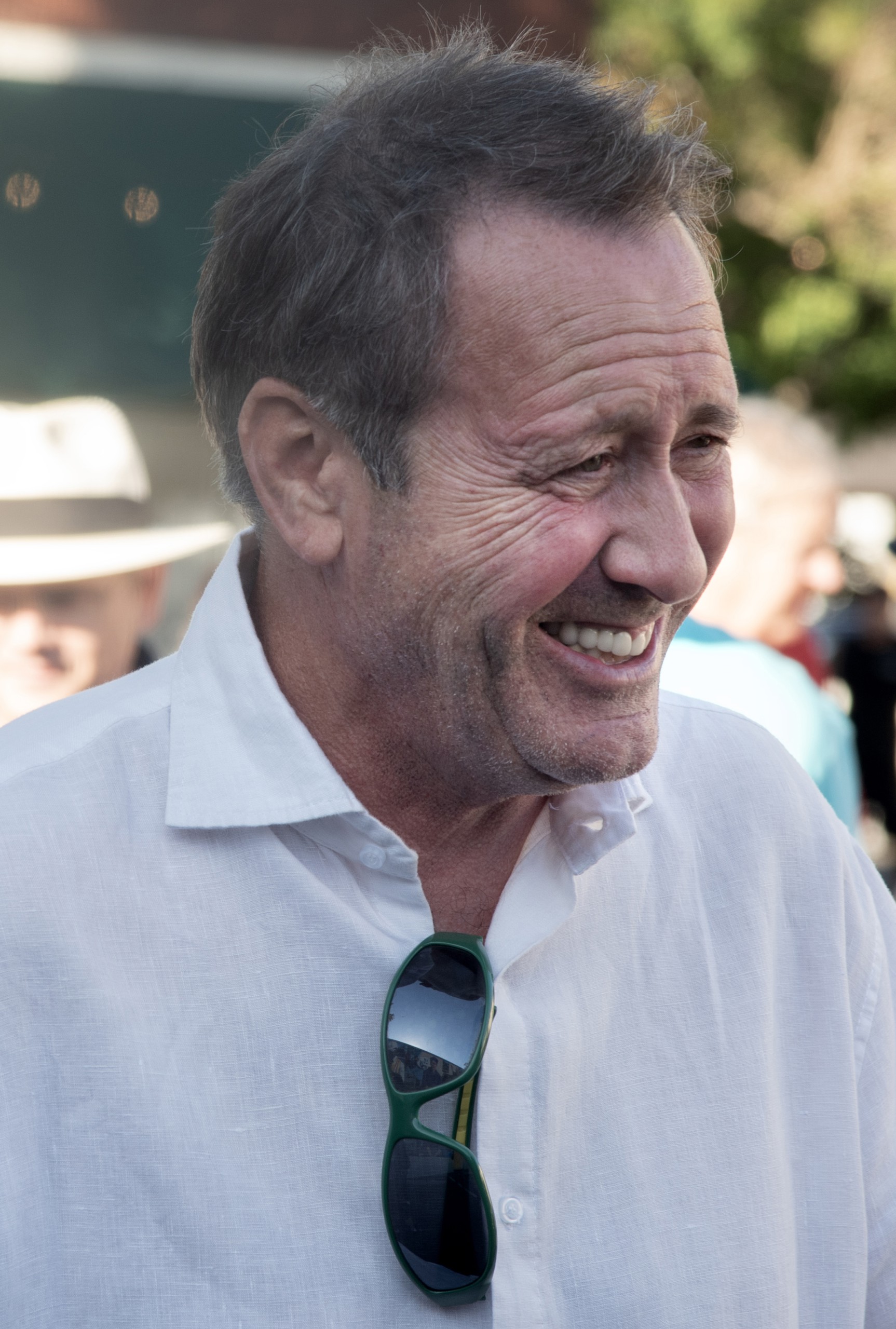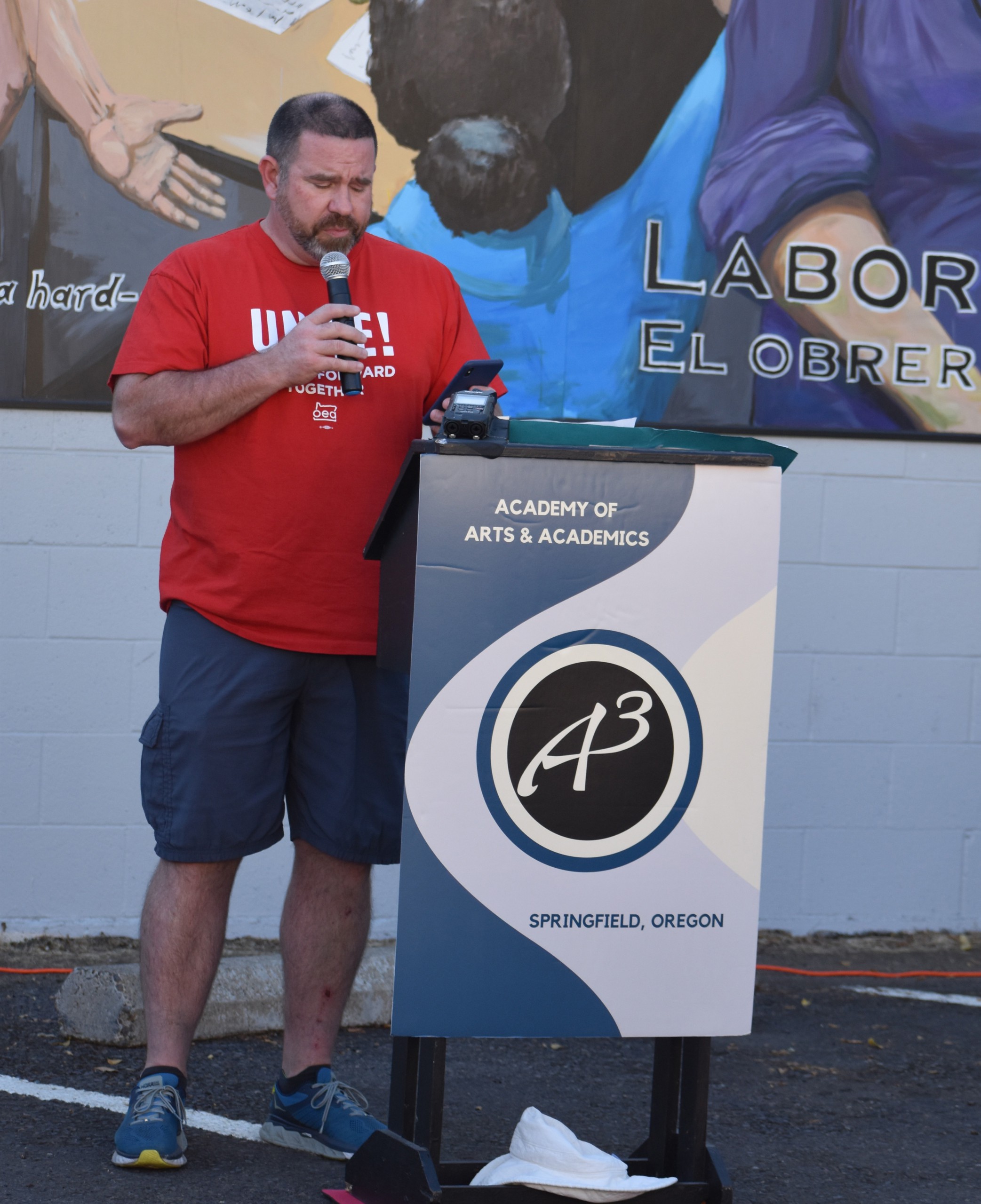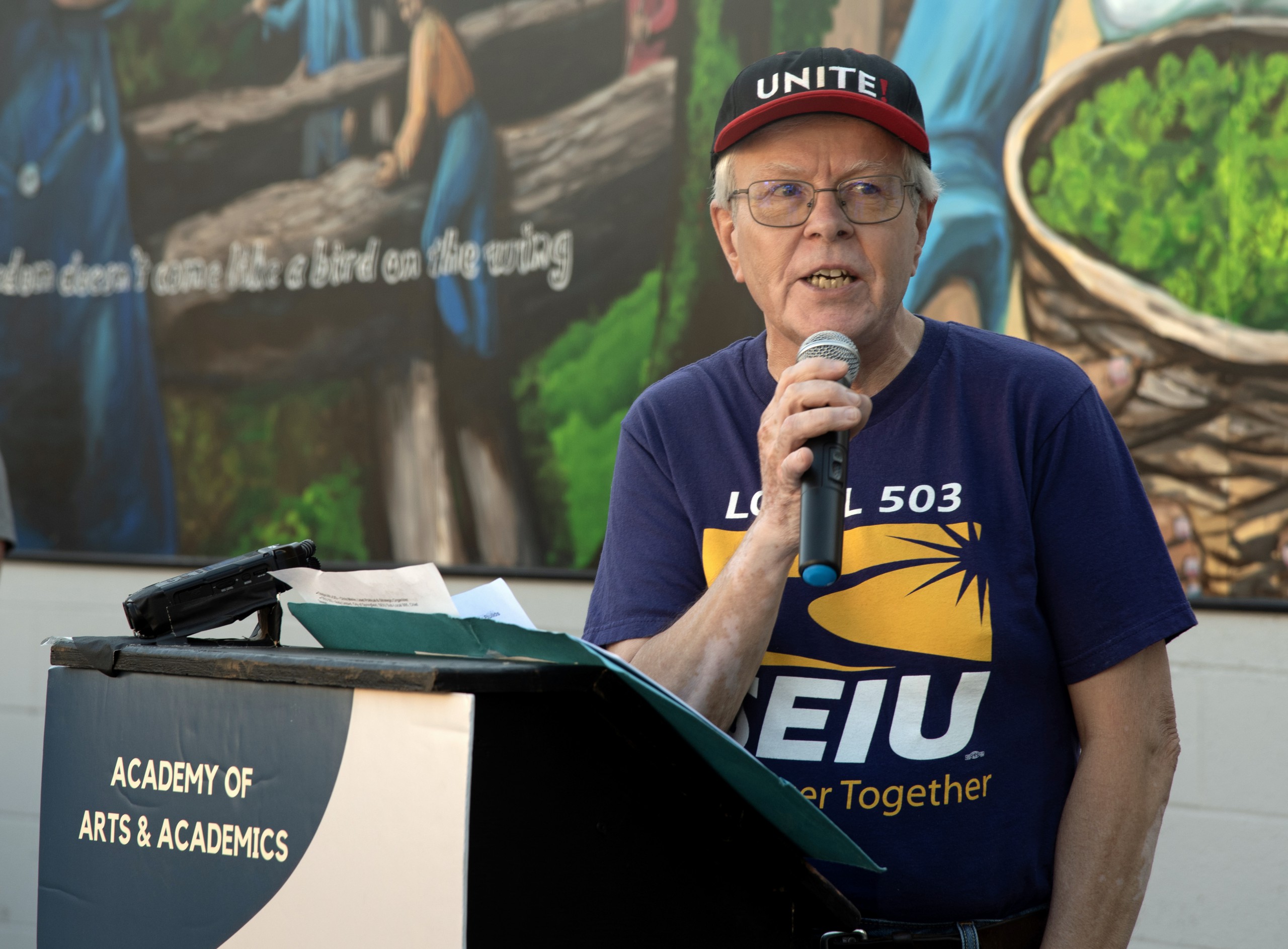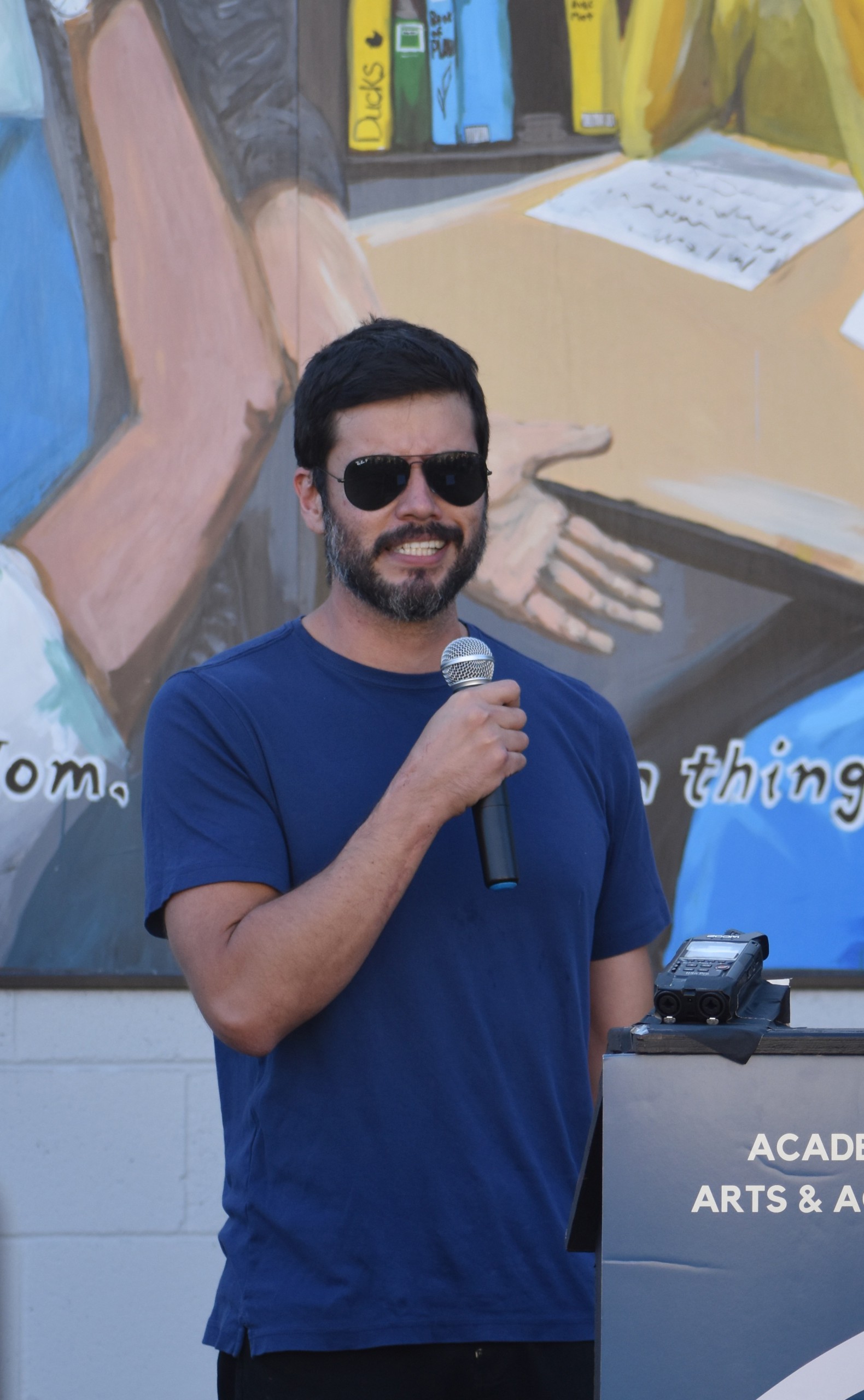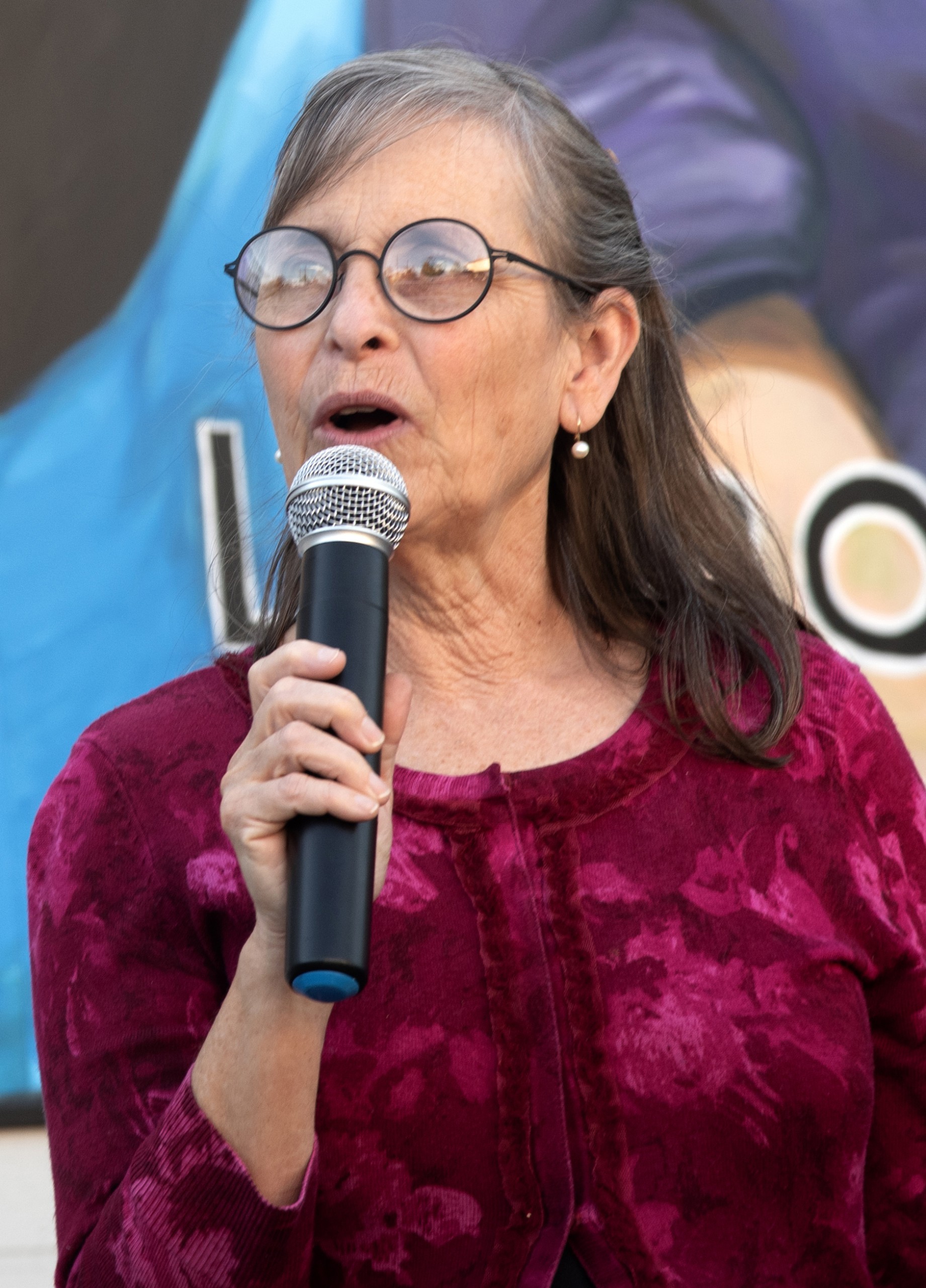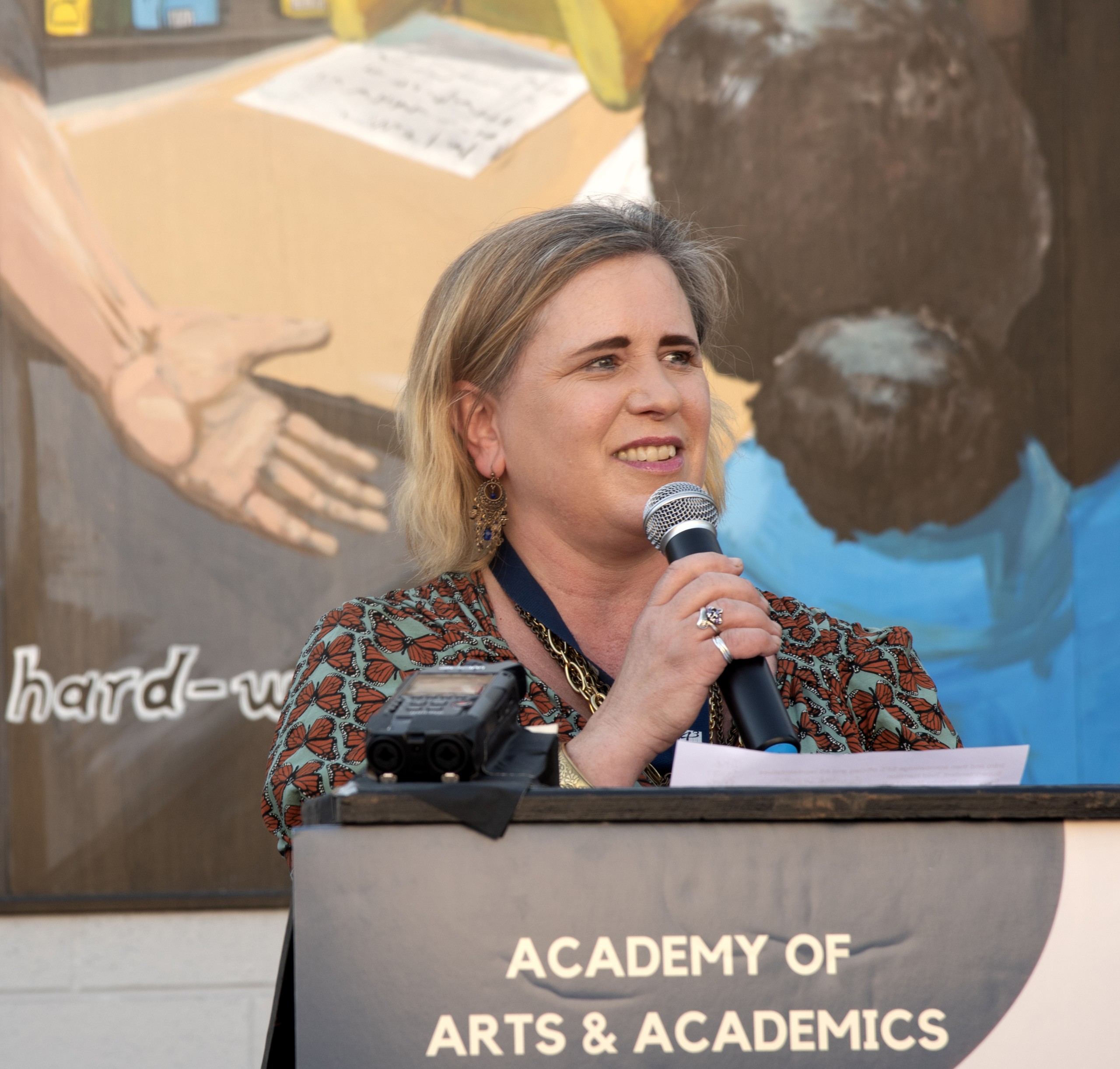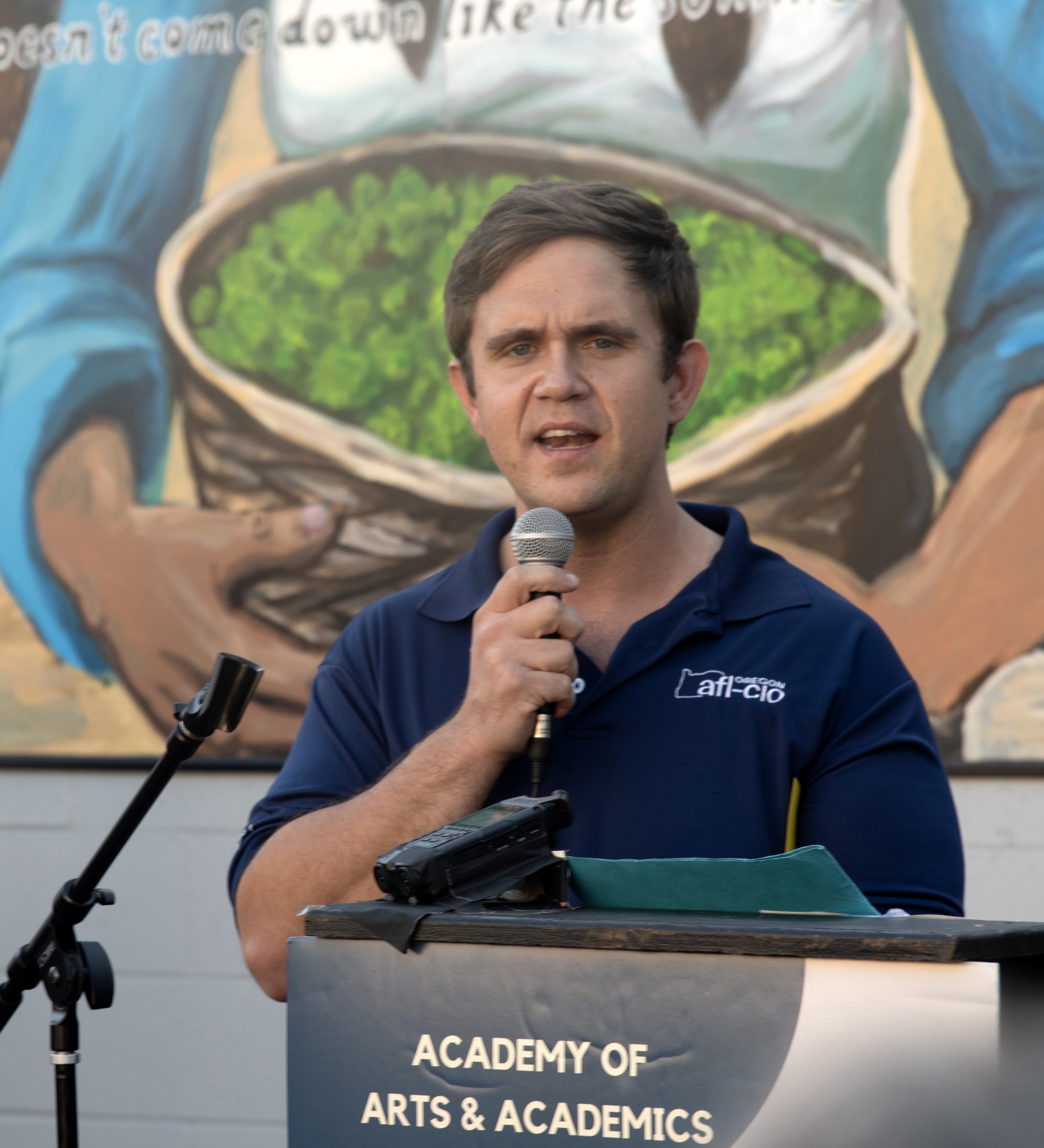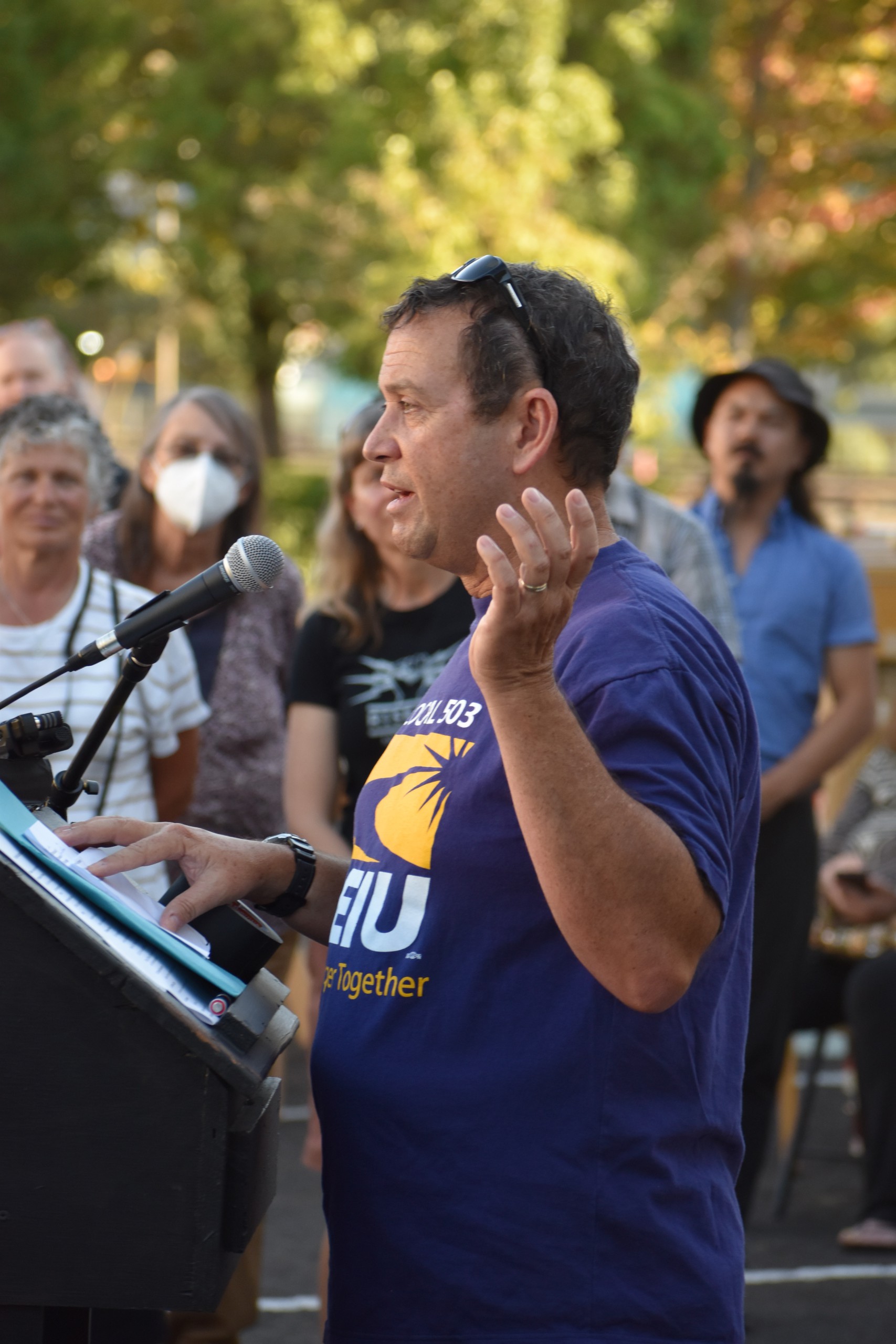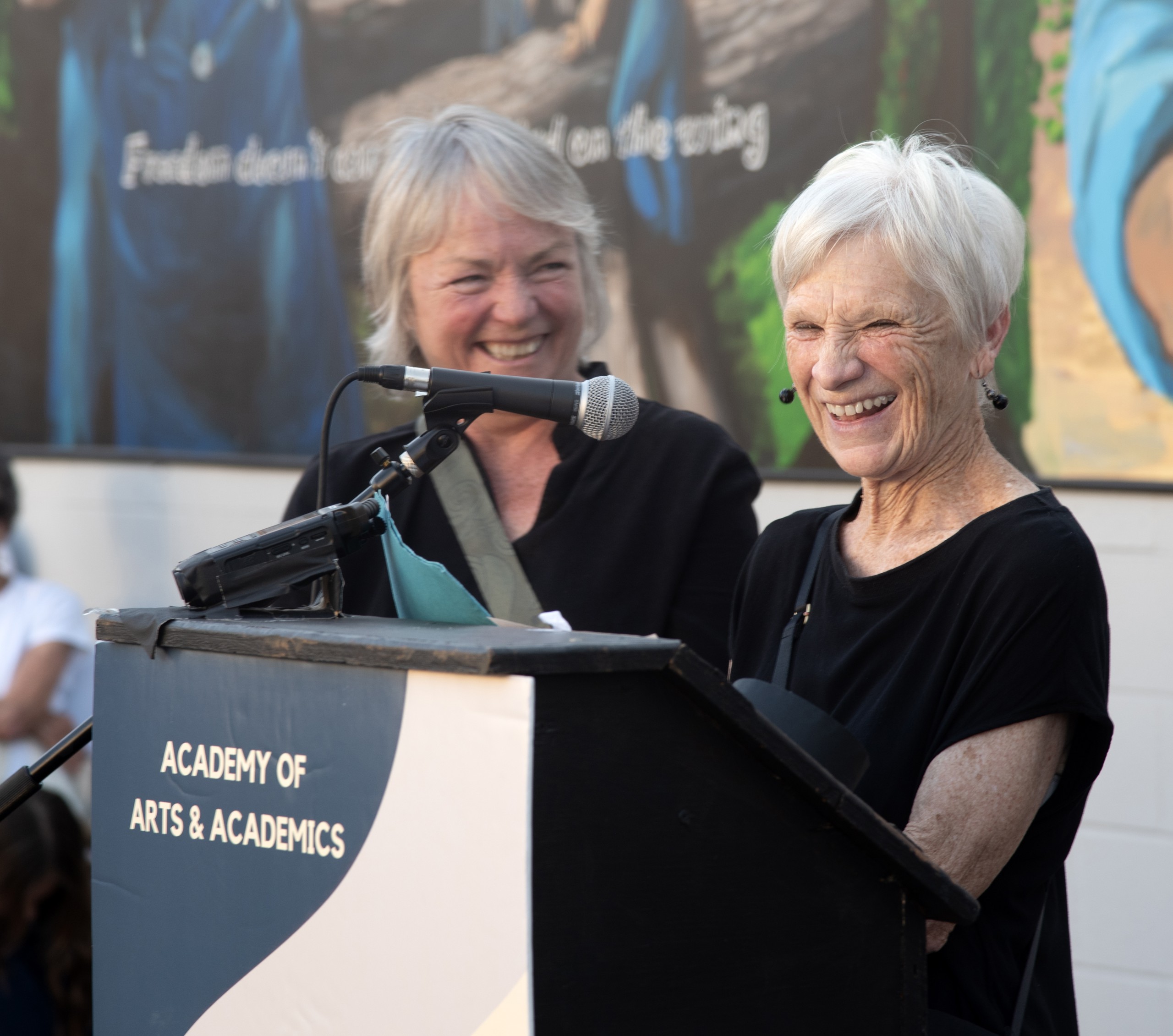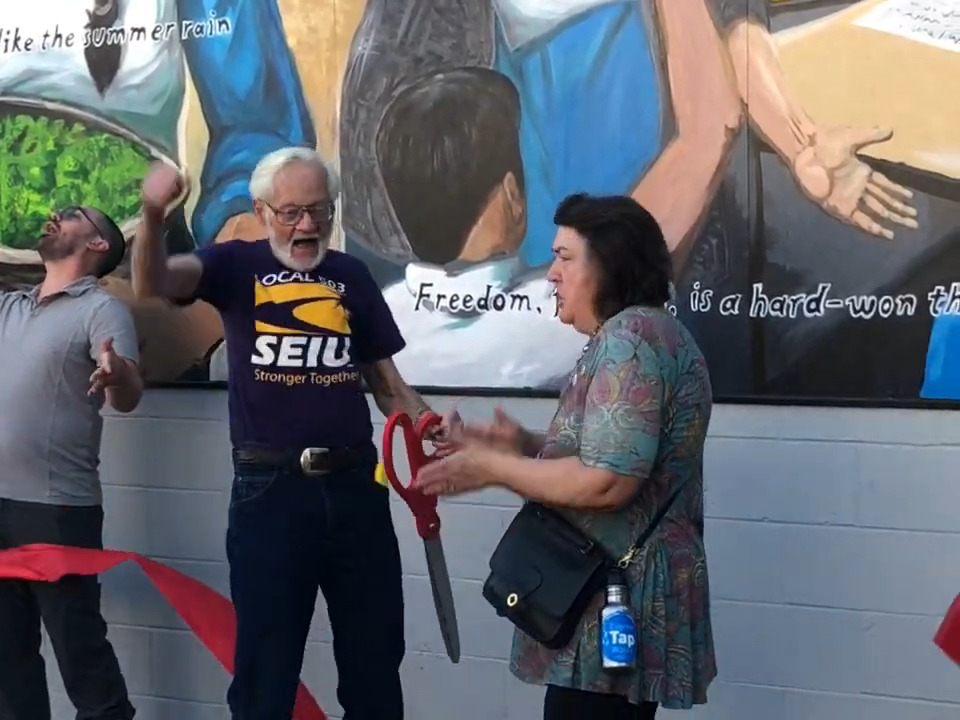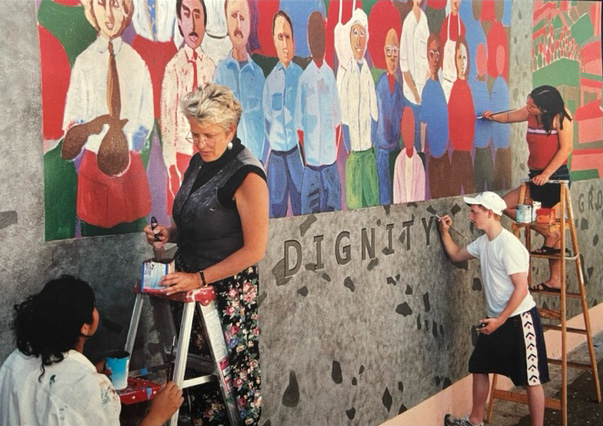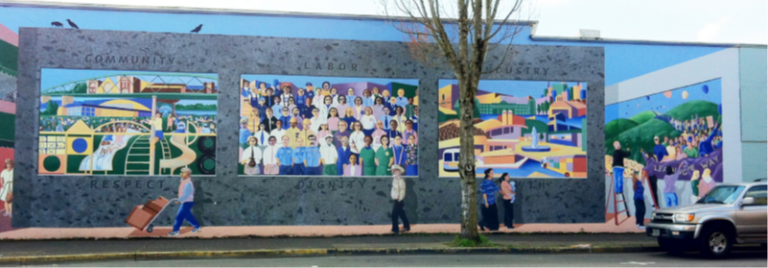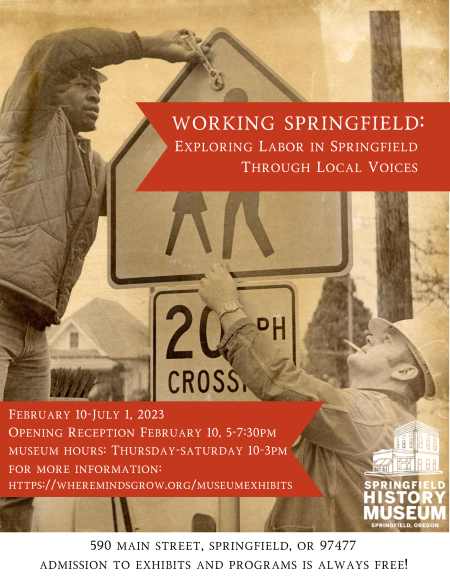Labor Builds Community / El Obrerismo Construye Comunidad
Mural at 645 Main St., Springfield (Academy of Arts and Academics – A3)
Artists: Alejandro Sarmiento (LAC Teaching Artist / Lead Artist, www.artwithalejandro.com), Jenny Cathey (A3 Co-Art Instructor), Nissie Ellison (A3 Art Instructor), 22 A3 Honors Art Students (Springfield Public Schools policy does not permit the release and publication of student names.)
Design Leads: Ben Minnis (LAC Arts Education Program Coordinator), Alejandro Sarmiento (LAC Teaching Artist/Lead Artist), Kurt Willcox (SEIU 503 Retiree)
Installation: Springfield Public Schools Facilities & Operations work crews, Terry Rutledge (Assistant Director)
Dedicated: September 8, 2023
Mural Design
Labor Builds Community / El Obrerismo Construye Comunidad celebrates the labor and struggles of generations of working people and their unions to build better lives for themselves, their families, and their communities. It emphasizes historically key sectors of the local economy and the need to work together to achieve common goals. This mural is also a successor and tribute to the Jessie Bostelle Memorial Mural that resided at 448 Main Street for over 20 years until it was removed in 2023.
The mural consists of six sections that move through time from left to right – from about the 1890’s to the present. Each section has a major character who represents the kind of labor described in that section. The first five sections focus on the local economy – timber, agriculture, education, health care, and government workers. They are meant to be a snapshot of what the work and working conditions were like in that sector during the era depicted. They also show how the workforce, economy, and landscape have changed over time.
The sixth section is a labor rally featuring a wide variety of workers from diverse industries. Their picket signs display some of the key issues workers fight for, the values unions stand for, and the ways workers have impacted their workplaces and communities. Most of all, the rally is meant to show that the improvements to workers’ lives that occurred in the earlier sections of the mural were the result of active worker struggles. And those struggles have always been more successful when working people have found ways to work together for common goals.
Embedded in the mural are the words of a song called “Pass It On” from a 1960s movie about the immigrant experience in the United States in the first part of the 20th century. The lyrics speak to the importance of struggle in securing the freedom to live a good life, and they remind us that that struggle is never finished. Our freedoms, our workplace gains, and the communities we build are always vulnerable, and we must be prepared to defend and improve them.
Here are the mural sections as they flow from left to right:
Timber, 1890-1920
Main Character: Timber Faller
The timber industry was the largest employer in Lane County at the turn of the 20th century. Timber falling, transportation, and milling was very dangerous work. Much of it was done by hand, though steam donkeys like the one in the mural, as well as horses and oxen were often used to move the fallen trees out of the forest. The logs were then processed in dozens of Lane County mills, often small or family operated. Waste from the milling process was typically burned in large furnaces known as wigwam burners, like the one pictured. Several labor organizations, notably the Industrial Workers of the World (IWW), tried to organize timber workers in the Northwest, but the timber owners fought hard to prevent this and many bloody, pitched battles were fought during this period. Beginning in the 1930s, union organizing efforts were much more successful, and the industry has been highly organized ever since. Timber remains a large industry and employer in Oregon in the 2020s, but mechanization has greatly reduced the number of people employed.
Agriculture, 1910-1930
Main Character: Hops Picker
Agriculture was the other major employer in Lane County at the start of the 20th century, but the bulk of the work was seasonal. A smaller number of regular employees, often members of the farm owner’s family, worked year-round planting and maintaining a wide range of crops – fruits, vegetables, nuts, and legumes. At harvest time, the workforce expanded greatly with families and children joining in. As is the case today, workers from out of the area were often brought in during this period to harvest the crops. In Lane County this included Kalapuya and Warm
Springs people, as pictured in the mural. Some farms used tractors and wagons for collecting the crops, but most of the work then was done by hand and most workers were paid piece rate. Agriculture continues to be a large seasonal employer and while farm work is more mechanized now, much of the harvesting work remains hand labor and most of it is done by Latino workers – both Oregon residents and guest workers. There were few efforts to organize agricultural workers in Oregon until the 1970s and 80s when PCUN (Pineros y Campesinos Unidos del Noroeste) was formed. The Springfield sign in the background is not a relic from “The Simpsons” television show. It actually existed on Willamette Heights just outside downtown from about 1909-1920 as a way of drawing travelers’ attention to the city.
Education, 1970-1990
Main Character: Elementary School Teacher
We’ve had public and private schools in Lane County since the late 19th century, including the University of Oregon which opened in 1876. The early schools were mostly community-based, taught basic skills, and scheduled around harvest seasons. In the first decades of the 20th century, Springfield and Eugene built more permanent school buildings and began to professionalize instruction. After World War II, as the area’s population grew rapidly, so did the number and size of educational institutions. That meant lots of teachers, support staff, bus drivers, administrators, and school buildings. During the period shown in the mural, students typically sat in rows of tables or desks and followed lessons directed by their teachers. Since then, the structure of classrooms, teaching techniques, and classroom equipment, especially computers and wireless technology, have changed significantly at all levels. With the passage of Oregon’s public worker collective bargaining law in 1973, teachers and other school workers began forming unions and bargaining with their school districts.
Health Care, 1990-2010
Main Character: Operating Room Nurse
Until the 1920’s, health care in Lane County was provided primarily by individual doctors, nurses, and midwives. If hospital care was needed, residents usually had to travel to Salem or Portland. Two hospitals were established in Eugene in the 1920’s. A third, McKenzie-Willamette, was constructed in Springfield in the 1950s as the result of a community campaign following a flood that had cut residents off from the Eugene hospitals. As these hospitals appeared and grew, the local area developed several nursing programs, most notably at Lane Community College. During the period shown in the mural, health care had already become one of our largest employers, with nurses, medical workers, and support staff in hospitals, but also in an array of other locations such as clinics, nursing homes, surgical and urgent care centers, as well as home care and hospice workers in peoples’ homes. Until the 1990s, most nursing organizations in Oregon were professional associations that worked to standardize nursing training, provide continuing education, and increase respect for the profession. Since then, nurses have increasingly formed unions, bargained contracts, worked to pass legislation and gone on strike to improve pay, working conditions, and patient care.
Government Workers, 2020s
Main Character: City Building Inspector
One of the most noticeable changes in the United States workforce after World War II was the increase in public sector employment. This was the case in Oregon and Lane County, as well. The services provided by local and state governments expanded, as did the need to maintain public facilities. In this section of the mural, you can see both the construction of a new building and the city inspector making sure it is being built to code. You can also see street maintenance workers sealing the cracks in the roadway. While many government workers like these are part of our daily lives, many others work in facilities or remotely and remain largely invisible to the public they serve – maintaining computer systems, processing paperwork, operating treatment plants, supporting elected officials, running transit systems, maintaining bike paths, and planning for future development. Like education workers, unionization among government workers has grown rapidly since the 1970s when it became legal in Oregon for them to organize and bargain with their employers. In the background you can see the intersection of 5th and Main Streets where the old Rivett Building stands. On the corner is the woman walking her dog who appeared in the Jessie Bostelle Memorial Mural and just to the right of her is where that mural used to be.
Union Advocacy, present day and future
Main Character: Union Organizer
Workers in the industry sectors featured in the mural and those in sectors not directly portrayed have helped build the communities we have today, and they will continue building our communities into the future simply by the work they perform every day. However, the biggest advances in working conditions, peoples’ daily lives, and community well-being have been the result of worker and union struggles both in the workplace and in the larger community. Those struggles have routinely required bringing together people who have very different experiences, backgrounds, interests, and beliefs to fight for important common goals.
Labor unions continue to be the most effective mechanism for building the solidarity and power needed to take on determined opposition from employers and bring about substantial changes on the job. Increasingly, though, the most significant issues for working people extend beyond the workplace and require larger solutions and broader alliances. Issues like access to affordable housing and childcare, fighting discrimination, health care for all, paid family leave, a clean and healthy environment, protecting democracy, and ensuring a just transition to new kinds of industries and jobs. These issues present serious challenges for working people and our organizations. More than ever, workers must resist being divided against each other and must find ways to work with groups we may not be used to partnering with. But if we maintain our willingness to struggle and work together, we can meet these challenges and continue to build our communities. ¡Si se puede!
“The labor movement (is) the principal force that (has) transformed misery and despair into hope and progress. Out of its bold struggles, economic and social reform gave birth to unemployment insurance, old-age pensions, government relief for the destitute and, above all, new wage levels that meant not mere survival, but a tolerable life. The captains of industry did not lead this transformation; they resisted it until they were overcome.”
– Dr. Martin Luther King, Jr. in 1965 on the 30th anniversary of the National Labor Relations Act
“Pass It On” Lyrics
Some of the lyrics to “Pass It On” are embedded in the mural. The lyrics speak to the importance of struggle in securing the freedom to live a good life, and they remind us that that struggle is never finished.
“Pass It On” was written by Millard Lampell and George Kleinsinger in 1964 as the theme song for “The Inheritance”, a film by Harold Mayer celebrating the 50th anniversary of the Amalgamated Clothing Workers of America (ACWA). Lampell also wrote the script for the movie. The union was initially based in New York City and its members were largely immigrants from Eastern Europe, predominantly Jewish. The ACWA fought for better wages, safer working conditions, sanitary housing, and against discrimination and child labor. You can view the one-hour movie through this link.
Freedom doesn’t come like a bird on the wing,
It doesn’t come down like the summer rain.
Freedom, freedom, is a hard-won thing.
You’ve got to work for it, fight for it,
Day and night for it
And every generation has to win it again.
Pass it on, mother,
Pass it on, brother.
You’ve got to work for it, fight for it,
Day and night for it.
Pass it on to your children,
Pass it on.
Springfield Labor Mural Project
The Springfield Labor Mural Project, which planned and developed the Labor Builds Community / El Obrerismo Construye Comunidad mural, began as a response to the elimination of the Jessie Bostelle Memorial Mural that had stood in downtown Springfield for over 20 years.
Damage and Removal of the Original Mural
In 2021, renovation work began on the 112 year-old Rivett Building property at 448 Main Street. This involved gutting the inside of the building and creating window openings in the outside wall. Unfortunately, that outside wall contained the Jessie Bostelle Memorial Mural. Four of those window openings were placed right in the middle of the mural.
Steve Salman, a retired state employee, and Star Homberg, a retired University of Oregon employee, both of whom had known Jessie Bostelle, were among the first to notice the damage. They contacted their union, Service Employees International Union (SEIU) 503, because it had been the driving force in creating the original mural. SEIU political staff member, Len Norwitz, who also worked with the union’s retirees, soon began to investigate the situation to see what could be done.
He and others contacted the City of Springfield Development and Public Works Department, whose staff is largely represented by SEIU 503, to determine if they could find an alternative to further damage and removal of the mural. They learned from Assistant City Manager Neil Laudati, who oversees the city’s public art program, that there was no way to preserve the mural or prevent its removal. Laudati, however, was very keen on helping find a suitable location for a new mural.
Planning for a New Mural
The labor group led by Leonard Stoehr, Springfield City Councilor and a staff member for Teamsters Local 206 in Lane County, Chris Maxie from the Oregon AFL-CIO, and Norwitz then began reaching out to other labor, art, and education folks to see if a different, more permanent site for a new mural could be found. In the winter and spring of 2022, they brought together volunteers and staff from labor and arts organizations in a series of Zoom meetings to brainstorm ideas. This group included representatives of the Springfield History Museum, retired staff from the Labor Education and Research Center (LERC) at the University of Oregon, and other union members. Thi Nguyen and Amy Orre from the Springfield Arts Commission joined the discussions and helped the group understand the variety of public art options available to them.
The needed breakthrough came in March 2022 when Stoehr met with Ame Beard, the principal of the Academy of Arts and Academics (A3). The A3 high school is a part of Springfield Public Schools and is located in downtown Springfield, less than two blocks from the site of the Jesse Bostelle Memorial Mural. Beard had already heard from numerous people about the damage to the mural, because many assumed that it had been painted by A3 students. She was eager to help, offered to have the new mural placed on the school wall that fronts their parking lot, and requested that this be a project A3 students could take part in. This fit the mural project group’s interests perfectly.
The expanded mural planning group soon began developing plans for creating and funding a new labor mural at the A3 high school. They contacted Lane Arts Council, which agreed to hire a lead Teaching Artist to work with the A3 students as part of their Artist Residency program and to be the repository for all funds raised. Springfield Public Schools formally agreed to let A3 put a labor mural on its building, subject to a review of the design. And the labor activists took on the task of publicizing the project and raising the money needed to fund the mural. During the spring and summer of 2022, the mural planning group developed a budget, drew up a project timeline, and proposed a theme for the new mural.
Developing the New Mural
In September 2022, the Springfield Labor Mural Project announced itself and began fundraising at the Labor Day Picnic sponsored by the Lane County Central Labor Chapter. Labor activists reached out to unions and other labor groups that fall and winter seeking input on what should be featured in the mural and asking for donations, in order to reach the budgeted goal of $15,000. They also contacted numerous elected officials for financial support.
Late in the year, the mural planning group began meeting with the Teaching Artist/Lead Artist, Alejandro Sarmiento, to share ideas about how to bring the mural theme, “Labor – Past, Present, and Future”, to life. They set up a design committee to oversee the content of the mural and eventually designated Sarmiento, Ben Minnis from the Lane Arts Council, and Kurt Willcox, an SEIU retiree, to bring back a design for the group to review and approve. By early April the small group had produced a draft design based around a slightly revised theme – “Labor Builds Community / El Obrerismo Construye Comunidad”, which the design committee discussed, edited, and then adopted.
The Springfield Labor Mural Project reached its $15,000 fundraising goal early in 2023. It had to raise that goal to $18,000, however, after learning that school district policy requires that murals be painted on panels, which are then mounted on building walls, rather than painting directly on the cinder blocks. The extra $3,000 was needed to cover the cost of the 4’ x 8’ aluminum panels, which the Lane Arts Council recommended as a longer lasting medium than the marine plywood used on older murals. The mural planning group secured the additional funds by early May 2023, Springfield Public Schools signed off on the mural design, and their Facilities & Operations Department took responsibility for mounting the mural once it was completed.
Contributors
Mural Planners, Designers, & Supporters
Teaching Artist / Lead Artist
Alejandro Sarmiento
Lane Arts Council Team
Eric Braman (Program Director), Ben Minnis (Arts Education Program Coordinator), Stacey Ray (Executive Director), Kari Welch (Development and Communication Coordinator)
Academy of Arts and Academics (A3)
Ame Beard (Principal), Jenny Cathey (Co-Art Instructor), Emerald Crafton (Finance/Business Manager), Nissie Ellison (Art Instructor)
Springfield Arts Commission
Thi Nguyen (Secretary), Amy Orre (Liaison)
City of Springfield, Administration
Vahana Horn (Economic Development Officer), Niel Laudati (Assistant City Manager), Leonard Stoehr (City Councilor and Teamster 206 Representative)
City of Springfield, Employees (SEIU Sub-Local 995)
Andy Limbird (Chief Steward), Maddi McGraw (History Museum Curator), Erin Selvey (President)
Labor
Chris Maxie (Oregon AFL-CIO), Jeff McGillivray (Lane County Central Labor Chapter), Len Norwitz (SEIU 503), Barbara Kellogg (SEIU 503 Retiree), Kurt Willcox (SEIU 503 Retiree), Bob Bussel (Labor Education and Research Center, UO Retiree), Marcus Widenor (Labor Education and Research Center, UO Retiree), Leigh Roberts (Labor Education and Research Center, UO), Jane Snar (Oregon Nurses Association)
Main Sponsors and Donors
Main Sponsors
- Lane Arts Council
- Springfield Public Schools
- City of Springfield
- Service Employees International Union (SEIU) Local 503
- Oregon AFL-CIO
- Lane County Central Labor Chapter
Donors
- SEIU 503 – Retiree Sub-Local 001: $2,000
- SEIU 503 – UO Classified Sub-Local 085: $2,000
- Oregon AFL-CIO: $1,684
- SEIU 503 – Executive Board: $1,500
- Lane County Central Labor Chapter – $1,000
- City of Springfield: $1,000
- State Representative Paul Holvey: $1,000
- State Representative John Lively: $1,000
- State Senator Lee Beyer: $500
- State Senator James Manning: $500
- Lane County Commissioner Joe Berney: $500
- AFSCME Local 1724 (City of Eugene): $500
- Lane Professional Fire Fighters IAFF-851: $500
- Oregon Nurses Association – McKenzie-Willamette Medical Center: $500
- Oregon Nurses Association – Sacred Heart Medical Center: $500
- Pacific Northwest Hospital Medicine Association: $500
- Labor Education Research Center (LERC – UO): $500
- Pacific Northwest Labor History Association: $500
- Amalgamated Transit Union (ATU) Division 757: $300
- Central Oregon Carpenters Local 271: $271
- Labor Day Picnic 2022 Donations: $258
- SEIU 503 – City of Springfield Sub-Local 995: $250
- Woodworkers W246 (IAM&AW): $250
- National Association of Letter Carriers – Branch 916: $112
- Lane County Commissioner Heather Buch: $100
- Springfield City Councilor Kori Rodley: $100
- Willamalane Park and Recreation District Director Chris Wig: $100
- Former State Representative Marty Wilde: $100
- AFSCME SW Oregon Retiree Union Sub-Chapter 41: $100
- Graduate Teaching Fellows Federation (UO) – AFT 3544: $100
- United Academics of the University of Oregon (UAUO): $100
- Michael Marchman: $100
- Kurt Willcox: $100
- Pat Riggs-Henson and Rick Henson: $100
- Springfield Education Association (SEA): $85
- Bill Ratteree: $50
- Ron Verzuh: $25
- Dave Stone: $10
- Lane ESD Director Rose Wilde
- Alice Dale
- Marion Malcolm
- Carrie Ann Naumoff
- Anonymous (3): $370
Total: $19,390 (as of 8/28/2023)
Making the Mural
On May 22, 2023, twenty-two A3 honors art students, under the direction of Teaching Artist/Lead Artist Alejandro Sarmiento, A3 Art Instructor Nissie Ellison, and A3 Co-Art Instructor Jenny Cathey, began transferring the mural design onto the aluminum panels.
Within a week they were painting in the basic color elements.
And by the end of the school term on June 16 the mural was nearly complete, except for some final detail work that was completed later by Sarmiento.
Then the Facilities & Operations Department of Springfield Public Schools prepared the wall to receive the mural by weeding, cleaning the wall, and painting it. They then added the hardware framework and mounted the mural.
Then Sarmiento painted in the lettering and he, with the support of Ben Minnis, covered the entire mural with an anti-graffiti coating.
Mural Dedication
On Friday, September 8, 2023, about 200 union members, arts supporters, elected officials, and friends of labor gathered at the Academy of Arts and Academics (A3) to celebrate the new labor mural – Labor Builds Community / El Obrerismo Construye Comunidad – and to remember the old one that is slowly disappearing two blocks away – the Jessie Bostelle Memorial Mural.
Video created by Thurston High School students.
We had music by Kwaziwai, a youth marimba band from the Kutsinhira Cultural Arts Center. There were families, activists, cake, and selfies.
From left to right: Springfield Mayor Sean Van Gordon was there along with several other elected officials, including Springfield City Councilor
Kori Rodley, State Representative Paul Holvey, and State Representative John Lively (not pictured.) Ben Minnis, Arts Education Program Director at the Lane Arts Council was Master of Ceremonies and Jonathan Gault, President of the Springfield Education Association, read the Springfield School District’s Land Acknowledgement.
Kurt Willcox from the Springfield Labor Mural Project and a retired SEIU member explained how the effort to create a new mural had come about and described the various elements of its design.
Then the artists spoke about the experience of painting the mural – Alejandro Sarmiento, the lead and teaching artist; Nissie Ellison, A3 Art Instructor; and Olivia Ellis Holden, one of the 22 A3 honors art students who did most of the painting.
Next, we heard from Ame Beard, principal of the A3 High School, which provided the location for the mural, and Stacey Ray, Executive Director of the Lane Arts Council, which hired Alejandro Sarmiento for the artist residency. They spoke about the importance of public art and arts education and the role labor plays in our communities.
Chris Maxie (left), Lead Political and Strategic Organizer for the Oregon AFL-CIO, spoke about that organization’s support for the mural, the current positive public perception of unions, and the importance of union organizing in a changing economy. City of Springfield employee Andy Limbird (middle), Chief Steward of SEIU 503 Sub-Local 995 at the city, brought greetings from the statewide union and described the new mural as part of the ongoing development of downtown Springfield.
Former City Councilor and Teamsters Representative Leonard Stoehr (right), who had spearheaded the effort early on to produce this mural travelled from Atlanta, Georgia to attend the dedication event. He praised the mural and thanked the various labor unions and elected officials whose sizeable contributions had provided much of the funding for the mural project.
Finally, Maureen Smith and Carole James, both former co-workers of Jessie Bostelle, talked about working with her, the impact she had on union training programs, and how much she inspired the many people she encountered. They described some of the bargaining and legislative victories Jessie helped bring about and spoke of her bravery in battling breast cancer. And they talked about the effort over 20 years ago to produce the mural that was a memorial to their friend, colleague, and mentor.
Then Steve Salman and Star Holmberg, the two SEIU member retirees who had noticed the damage being done to the Jessie Bostelle Memorial Mural nearly two years earlier, led the ribbon cutting ceremony to officially dedicate our new labor mural – Labor Builds Community / El Obrerismo Construye Comunidad.
Land Acknowledgement
For centuries, the mural’s location at 645 Main Street was part of the traditional homeland of the Kalapuya people. We want to honor this reality by including the “Land Acknowledgement” that Springfield Public Schools has adopted and recites at its meetings. We offer thanks, as well, to Dawn Malliett, Executive Director of the District’s Chifin Native Youth Center who provided advice on our mural design and was actively involved in developing this “Land Acknowledgement”.
“We acknowledge that we are in the traditional homeland of the Kalapuya people, specifically the community that was known as Chifin, the area that we now call Springfield.
Kalapuya people, who have lived in this region since “Time Immemorial”, were illegally dispossessed of their land and forcibly removed to what are now the Grand Ronde and Siletz reservations over several years, but most notably in treaties between 1851 and 1855.
The Kalapuya are now members of the Confederated Tribes of the Grand Ronde and the Confederated Tribes of Siletz Indians, and members of the Kalapuya still live, work, study, and thrive in this area, and continue to make important contributions here in Springfield, across the land we now refer to as Oregon, and around the globe.
This information is shared out of a responsibility to honor the heritage and the humanity of all people and to promote unity within our school district.”
Jessie Bostelle Memorial Mural
Jessie Bostelle was an organizer, field coordinator, and Director of Education for Service Employees International Union (SEIU) Local 503, based in Lane County. She also regularly taught for the Labor Education and Research Center (LERC) at the University of Oregon. Eventually, Jessie was hired by the international union in Washington, D.C. to be its Director of Education. She was a fierce advocate of women taking leadership roles in their unions and was greatly admired and respected within the Oregon labor movement. One of her proudest accomplishments was helping pass a ballot measure in 1996 that significantly raised the state’s minimum wage.
Jessie was 51 years old when she died of breast cancer in 1999 after a four-year struggle. During her illness she helped found an education and counseling center for breast cancer survivors in Eugene. Jessie was also active in the local art and music communities.
Friends and co-workers at SEIU and LERC got together with the Lane Arts Council and the Springfield Arts Commission to develop and fund a mural honoring Jessie’s dedication to working people. They hired Alison McNair and her assistant, Jamie King, to create a mural that focused on the things Jessie valued greatly – education, work, and community.
McNair began working on the mural project in early 2001 with the assistance of seven young people from Thurston and Springfield High Schools and the Gateway Learning Center. They included Elise Baird, Brianna Hunt, Nevada Sisney, Amy Poteet, Nick Clough, Jeff Suchanek, and Darlene Ryan. The location they secured for the mural was 448 Main Street on the east side of the Rivett Building.
The students conducted research about the labor movement with the assistance of LERC faculty. This included meeting directly with union leaders in Springfield. They also learned about mural design, created initial sketches for the project, and presented the final design to the Springfield Arts Commission for approval. The students divided the mural into three sections – Community, Labor, and Industry, and linked them to the key concepts of Respect, Dignity, and Growth.
The Jessie Bostelle Memorial Mural was also a tribute to the neighborhood where it resided. Some of the people featured in the mural were neighborhood residents who regularly checked on the progress of the mural as it was being painted. Other figures included local business owners and passersby out for a stroll, such as the woman walking her dog near the sign dedicating the mural in Jessie’s honor.
Painting of the mural began in March 2001 and was completed in June. The mural was publicly dedicated on June 18, 2001. Destruction of the mural commenced in 2021 and continued into 2023. Unfortunately, McNair died in July 2023 just before completion of the new labor mural.
If you look carefully at the Labor panel of her mural, you can see Jessie Bostelle near the middle in a purple SEIU 503 t-shirt wearing glasses. Of course, Jessie has a prominent place in the new “Labor Builds Community / El Obrerismo Construye Comunidad” mural. You will also find the woman walking her dog there on the corner where the Jesse Bostelle Memorial Mural once stood.
Working Springfield Exhibit
During the fall and early winter of 2022-23, Bob Bussel and Marcus Widenor, retired faculty from the Labor Education and Research Center (LERC) at the University of Oregon, worked with Maddi McGraw, curator of the Springfield History Museum and a member of SEIU 503 Sub-Local 995 at the city, to develop an oral history exhibit about work and unions in Springfield. It was called “Working Springfield: Exploring Labor in Springfield Through Local Voices”. This was a stand-alone exhibit, but it was also meant to pave the way for the new labor mural that was then being planned for the A3 high school.
Bussel and Widenor recruited nearly a dozen people who had worked or continued to work in Springfield in a wide variety of occupations. They recorded interviews with each of them and included those interviews in the exhibit both visually on small monitors and transcribed for reading. In addition, they constructed and displayed a timeline of important labor events in Springfield and Oregon. McGraw provided the technology and developed all the staging for the exhibit. It opened on February 10, 2023 with a well-attended reception that included refreshments and labor songs provided by Chico Schwall. The exhibit closed on June 30, 2023.
Those interviewed include:
- Bill Bradley – bus tire specialist and union representative
- Casey Houpert – barista
- Johanis Tadeo – community organizer
- John Lovdokken – high school teacher
- Paul Goldberg – nurse and union representative
- Tom Thede – log truck driver and union officer
- Kristen Curé – librarian
- Rachel Dennis – hospital heart monitor technician
- Fidel Guerra Cuevas – health care shipping and receiving coordinator
- LeRoy Robinson – mill shipping clerk and union officer
- Jennifer Snyder – typesetter, home care worker, and union representative



